Australia's Biodiversity: Environmental Impacts and Unique Species
VerifiedAdded on 2022/12/21
|20
|6034
|88
AI Summary
The report covers Australia’s biodiversity, focusing on the environmental impacts of climate change. It discusses unique species like koalas and northern bettongs and highlights the effects of deforestation, overgrazing, introduction of exotic species, pollution, and infrastructure development. The report also explores the Great Barrier Reef and the Blue Mountain Water Skink. It emphasizes the importance of studying biodiversity and understanding the factors affecting it.
Contribute Materials
Your contribution can guide someone’s learning journey. Share your
documents today.

COVER PAGE.
i
i
Secure Best Marks with AI Grader
Need help grading? Try our AI Grader for instant feedback on your assignments.

ABSTRACT.
The report covers Australia’s biodiversity. Significant parts of the report explain the
environmental impacts on nature due to continuous climate change in Australia. Different unique
species and features found in Australia have been discussed in detail showing their possibility of
existence in the next future. Examples of the individual species explained are koalas and
northern bettongs. The report generally indicates the effects of climate change in Australia to the
environment.
ii
The report covers Australia’s biodiversity. Significant parts of the report explain the
environmental impacts on nature due to continuous climate change in Australia. Different unique
species and features found in Australia have been discussed in detail showing their possibility of
existence in the next future. Examples of the individual species explained are koalas and
northern bettongs. The report generally indicates the effects of climate change in Australia to the
environment.
ii
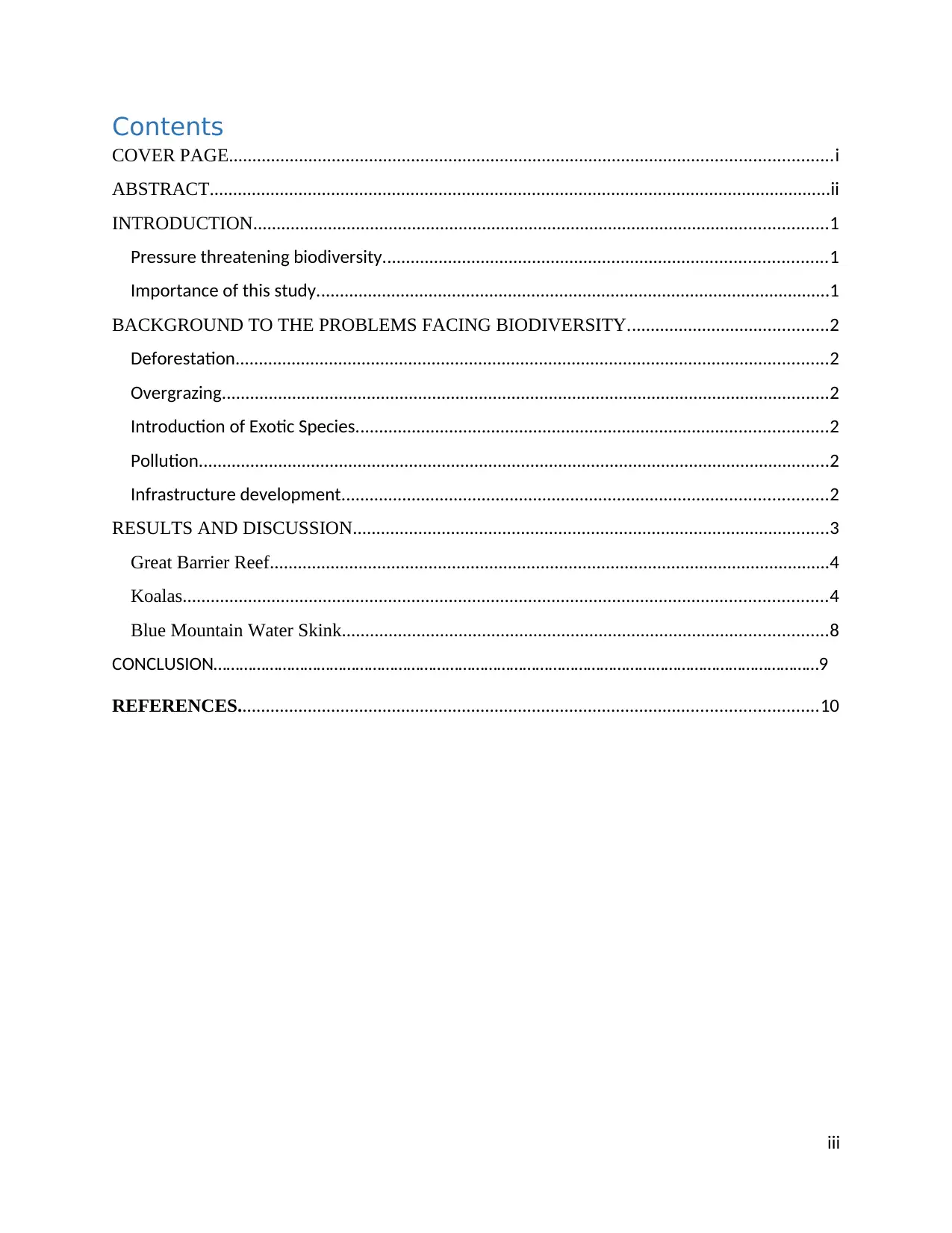
Contents
COVER PAGE.................................................................................................................................i
ABSTRACT.....................................................................................................................................ii
INTRODUCTION...........................................................................................................................1
Pressure threatening biodiversity...............................................................................................1
Importance of this study..............................................................................................................1
BACKGROUND TO THE PROBLEMS FACING BIODIVERSITY...........................................2
Deforestation...............................................................................................................................2
Overgrazing..................................................................................................................................2
Introduction of Exotic Species.....................................................................................................2
Pollution.......................................................................................................................................2
Infrastructure development........................................................................................................2
RESULTS AND DISCUSSION......................................................................................................3
Great Barrier Reef........................................................................................................................4
Koalas..........................................................................................................................................4
Blue Mountain Water Skink........................................................................................................8
CONCLUSION……………………………………………………………………………………………………………………………9
REFERENCES............................................................................................................................10
iii
COVER PAGE.................................................................................................................................i
ABSTRACT.....................................................................................................................................ii
INTRODUCTION...........................................................................................................................1
Pressure threatening biodiversity...............................................................................................1
Importance of this study..............................................................................................................1
BACKGROUND TO THE PROBLEMS FACING BIODIVERSITY...........................................2
Deforestation...............................................................................................................................2
Overgrazing..................................................................................................................................2
Introduction of Exotic Species.....................................................................................................2
Pollution.......................................................................................................................................2
Infrastructure development........................................................................................................2
RESULTS AND DISCUSSION......................................................................................................3
Great Barrier Reef........................................................................................................................4
Koalas..........................................................................................................................................4
Blue Mountain Water Skink........................................................................................................8
CONCLUSION……………………………………………………………………………………………………………………………9
REFERENCES............................................................................................................................10
iii
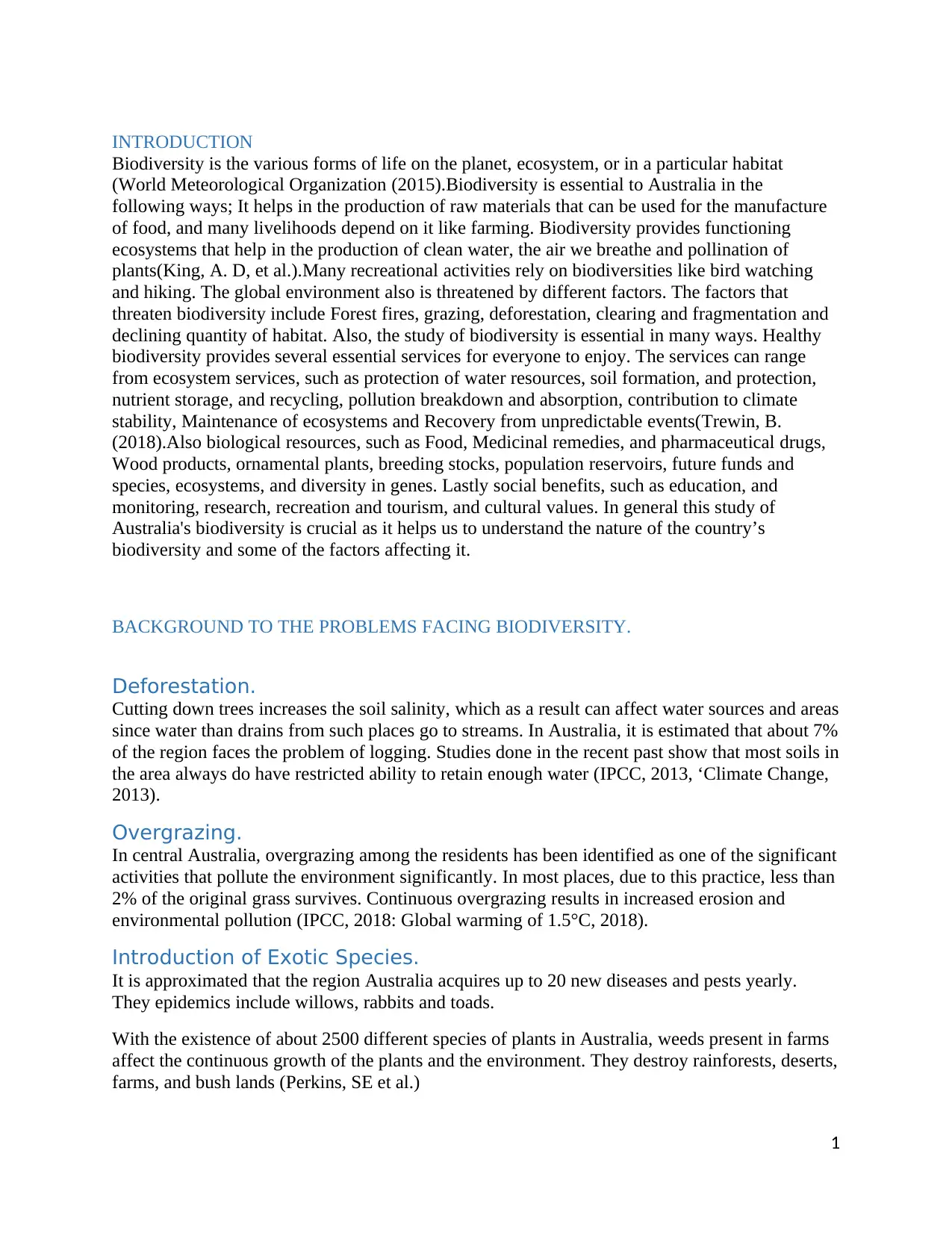
INTRODUCTION
Biodiversity is the various forms of life on the planet, ecosystem, or in a particular habitat
(World Meteorological Organization (2015).Biodiversity is essential to Australia in the
following ways; It helps in the production of raw materials that can be used for the manufacture
of food, and many livelihoods depend on it like farming. Biodiversity provides functioning
ecosystems that help in the production of clean water, the air we breathe and pollination of
plants(King, A. D, et al.).Many recreational activities rely on biodiversities like bird watching
and hiking. The global environment also is threatened by different factors. The factors that
threaten biodiversity include Forest fires, grazing, deforestation, clearing and fragmentation and
declining quantity of habitat. Also, the study of biodiversity is essential in many ways. Healthy
biodiversity provides several essential services for everyone to enjoy. The services can range
from ecosystem services, such as protection of water resources, soil formation, and protection,
nutrient storage, and recycling, pollution breakdown and absorption, contribution to climate
stability, Maintenance of ecosystems and Recovery from unpredictable events(Trewin, B.
(2018).Also biological resources, such as Food, Medicinal remedies, and pharmaceutical drugs,
Wood products, ornamental plants, breeding stocks, population reservoirs, future funds and
species, ecosystems, and diversity in genes. Lastly social benefits, such as education, and
monitoring, research, recreation and tourism, and cultural values. In general this study of
Australia's biodiversity is crucial as it helps us to understand the nature of the country’s
biodiversity and some of the factors affecting it.
BACKGROUND TO THE PROBLEMS FACING BIODIVERSITY.
Deforestation.
Cutting down trees increases the soil salinity, which as a result can affect water sources and areas
since water than drains from such places go to streams. In Australia, it is estimated that about 7%
of the region faces the problem of logging. Studies done in the recent past show that most soils in
the area always do have restricted ability to retain enough water (IPCC, 2013, ‘Climate Change,
2013).
Overgrazing.
In central Australia, overgrazing among the residents has been identified as one of the significant
activities that pollute the environment significantly. In most places, due to this practice, less than
2% of the original grass survives. Continuous overgrazing results in increased erosion and
environmental pollution (IPCC, 2018: Global warming of 1.5°C, 2018).
Introduction of Exotic Species.
It is approximated that the region Australia acquires up to 20 new diseases and pests yearly.
They epidemics include willows, rabbits and toads.
With the existence of about 2500 different species of plants in Australia, weeds present in farms
affect the continuous growth of the plants and the environment. They destroy rainforests, deserts,
farms, and bush lands (Perkins, SE et al.)
1
Biodiversity is the various forms of life on the planet, ecosystem, or in a particular habitat
(World Meteorological Organization (2015).Biodiversity is essential to Australia in the
following ways; It helps in the production of raw materials that can be used for the manufacture
of food, and many livelihoods depend on it like farming. Biodiversity provides functioning
ecosystems that help in the production of clean water, the air we breathe and pollination of
plants(King, A. D, et al.).Many recreational activities rely on biodiversities like bird watching
and hiking. The global environment also is threatened by different factors. The factors that
threaten biodiversity include Forest fires, grazing, deforestation, clearing and fragmentation and
declining quantity of habitat. Also, the study of biodiversity is essential in many ways. Healthy
biodiversity provides several essential services for everyone to enjoy. The services can range
from ecosystem services, such as protection of water resources, soil formation, and protection,
nutrient storage, and recycling, pollution breakdown and absorption, contribution to climate
stability, Maintenance of ecosystems and Recovery from unpredictable events(Trewin, B.
(2018).Also biological resources, such as Food, Medicinal remedies, and pharmaceutical drugs,
Wood products, ornamental plants, breeding stocks, population reservoirs, future funds and
species, ecosystems, and diversity in genes. Lastly social benefits, such as education, and
monitoring, research, recreation and tourism, and cultural values. In general this study of
Australia's biodiversity is crucial as it helps us to understand the nature of the country’s
biodiversity and some of the factors affecting it.
BACKGROUND TO THE PROBLEMS FACING BIODIVERSITY.
Deforestation.
Cutting down trees increases the soil salinity, which as a result can affect water sources and areas
since water than drains from such places go to streams. In Australia, it is estimated that about 7%
of the region faces the problem of logging. Studies done in the recent past show that most soils in
the area always do have restricted ability to retain enough water (IPCC, 2013, ‘Climate Change,
2013).
Overgrazing.
In central Australia, overgrazing among the residents has been identified as one of the significant
activities that pollute the environment significantly. In most places, due to this practice, less than
2% of the original grass survives. Continuous overgrazing results in increased erosion and
environmental pollution (IPCC, 2018: Global warming of 1.5°C, 2018).
Introduction of Exotic Species.
It is approximated that the region Australia acquires up to 20 new diseases and pests yearly.
They epidemics include willows, rabbits and toads.
With the existence of about 2500 different species of plants in Australia, weeds present in farms
affect the continuous growth of the plants and the environment. They destroy rainforests, deserts,
farms, and bush lands (Perkins, SE et al.)
1
Secure Best Marks with AI Grader
Need help grading? Try our AI Grader for instant feedback on your assignments.
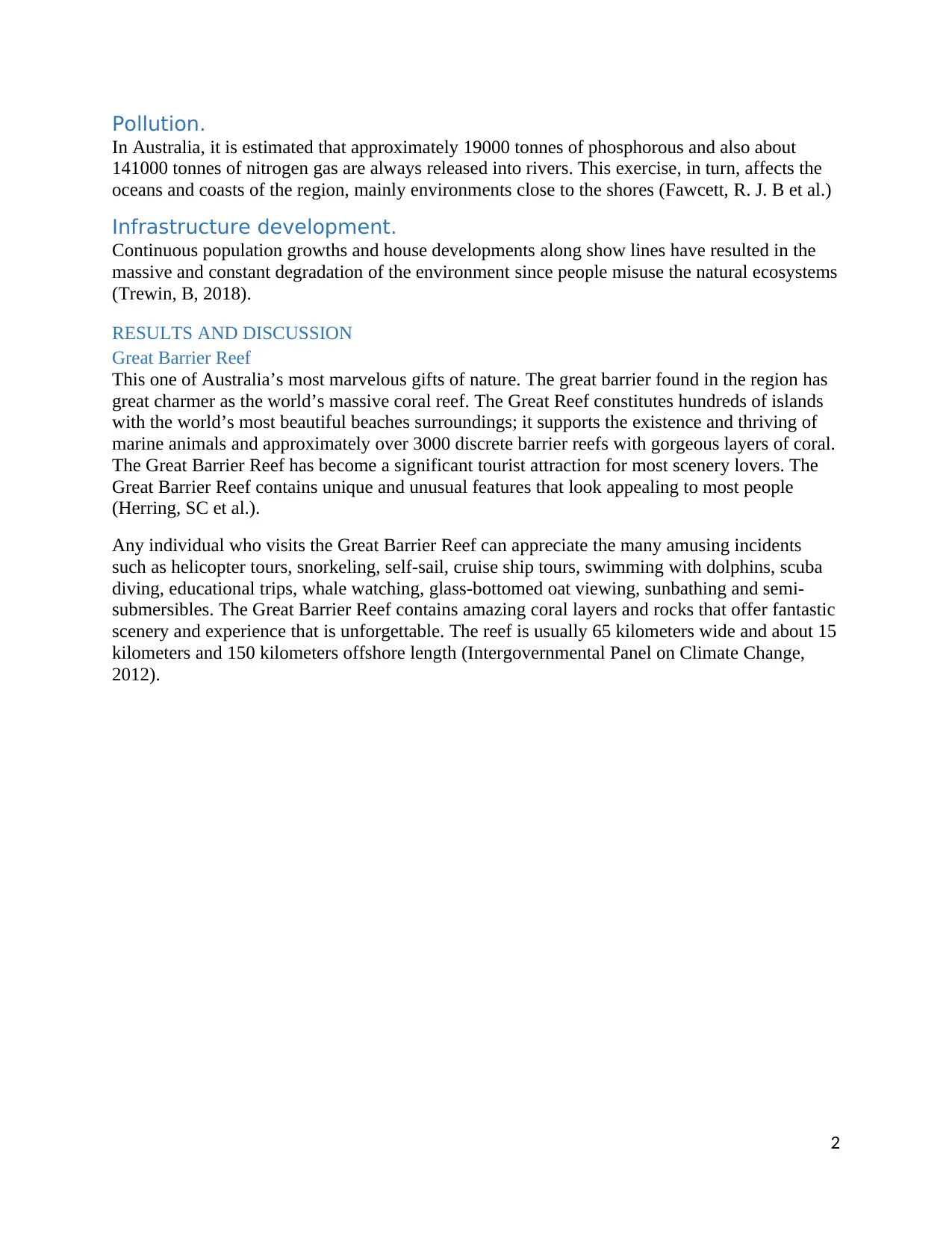
Pollution.
In Australia, it is estimated that approximately 19000 tonnes of phosphorous and also about
141000 tonnes of nitrogen gas are always released into rivers. This exercise, in turn, affects the
oceans and coasts of the region, mainly environments close to the shores (Fawcett, R. J. B et al.)
Infrastructure development.
Continuous population growths and house developments along show lines have resulted in the
massive and constant degradation of the environment since people misuse the natural ecosystems
(Trewin, B, 2018).
RESULTS AND DISCUSSION
Great Barrier Reef
This one of Australia’s most marvelous gifts of nature. The great barrier found in the region has
great charmer as the world’s massive coral reef. The Great Reef constitutes hundreds of islands
with the world’s most beautiful beaches surroundings; it supports the existence and thriving of
marine animals and approximately over 3000 discrete barrier reefs with gorgeous layers of coral.
The Great Barrier Reef has become a significant tourist attraction for most scenery lovers. The
Great Barrier Reef contains unique and unusual features that look appealing to most people
(Herring, SC et al.).
Any individual who visits the Great Barrier Reef can appreciate the many amusing incidents
such as helicopter tours, snorkeling, self-sail, cruise ship tours, swimming with dolphins, scuba
diving, educational trips, whale watching, glass-bottomed oat viewing, sunbathing and semi-
submersibles. The Great Barrier Reef contains amazing coral layers and rocks that offer fantastic
scenery and experience that is unforgettable. The reef is usually 65 kilometers wide and about 15
kilometers and 150 kilometers offshore length (Intergovernmental Panel on Climate Change,
2012).
2
In Australia, it is estimated that approximately 19000 tonnes of phosphorous and also about
141000 tonnes of nitrogen gas are always released into rivers. This exercise, in turn, affects the
oceans and coasts of the region, mainly environments close to the shores (Fawcett, R. J. B et al.)
Infrastructure development.
Continuous population growths and house developments along show lines have resulted in the
massive and constant degradation of the environment since people misuse the natural ecosystems
(Trewin, B, 2018).
RESULTS AND DISCUSSION
Great Barrier Reef
This one of Australia’s most marvelous gifts of nature. The great barrier found in the region has
great charmer as the world’s massive coral reef. The Great Reef constitutes hundreds of islands
with the world’s most beautiful beaches surroundings; it supports the existence and thriving of
marine animals and approximately over 3000 discrete barrier reefs with gorgeous layers of coral.
The Great Barrier Reef has become a significant tourist attraction for most scenery lovers. The
Great Barrier Reef contains unique and unusual features that look appealing to most people
(Herring, SC et al.).
Any individual who visits the Great Barrier Reef can appreciate the many amusing incidents
such as helicopter tours, snorkeling, self-sail, cruise ship tours, swimming with dolphins, scuba
diving, educational trips, whale watching, glass-bottomed oat viewing, sunbathing and semi-
submersibles. The Great Barrier Reef contains amazing coral layers and rocks that offer fantastic
scenery and experience that is unforgettable. The reef is usually 65 kilometers wide and about 15
kilometers and 150 kilometers offshore length (Intergovernmental Panel on Climate Change,
2012).
2
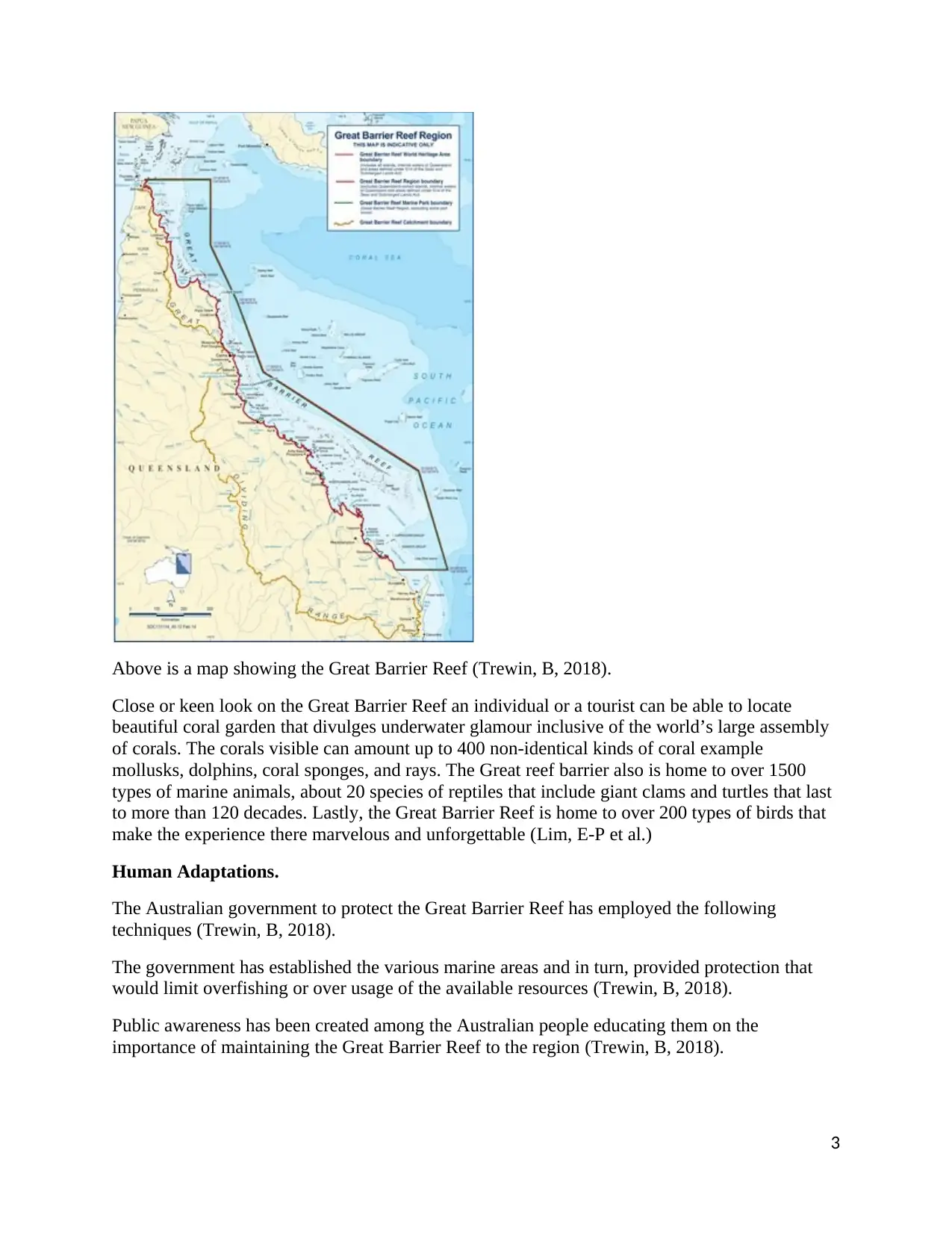
Above is a map showing the Great Barrier Reef (Trewin, B, 2018).
Close or keen look on the Great Barrier Reef an individual or a tourist can be able to locate
beautiful coral garden that divulges underwater glamour inclusive of the world’s large assembly
of corals. The corals visible can amount up to 400 non-identical kinds of coral example
mollusks, dolphins, coral sponges, and rays. The Great reef barrier also is home to over 1500
types of marine animals, about 20 species of reptiles that include giant clams and turtles that last
to more than 120 decades. Lastly, the Great Barrier Reef is home to over 200 types of birds that
make the experience there marvelous and unforgettable (Lim, E-P et al.)
Human Adaptations.
The Australian government to protect the Great Barrier Reef has employed the following
techniques (Trewin, B, 2018).
The government has established the various marine areas and in turn, provided protection that
would limit overfishing or over usage of the available resources (Trewin, B, 2018).
Public awareness has been created among the Australian people educating them on the
importance of maintaining the Great Barrier Reef to the region (Trewin, B, 2018).
3
Close or keen look on the Great Barrier Reef an individual or a tourist can be able to locate
beautiful coral garden that divulges underwater glamour inclusive of the world’s large assembly
of corals. The corals visible can amount up to 400 non-identical kinds of coral example
mollusks, dolphins, coral sponges, and rays. The Great reef barrier also is home to over 1500
types of marine animals, about 20 species of reptiles that include giant clams and turtles that last
to more than 120 decades. Lastly, the Great Barrier Reef is home to over 200 types of birds that
make the experience there marvelous and unforgettable (Lim, E-P et al.)
Human Adaptations.
The Australian government to protect the Great Barrier Reef has employed the following
techniques (Trewin, B, 2018).
The government has established the various marine areas and in turn, provided protection that
would limit overfishing or over usage of the available resources (Trewin, B, 2018).
Public awareness has been created among the Australian people educating them on the
importance of maintaining the Great Barrier Reef to the region (Trewin, B, 2018).
3
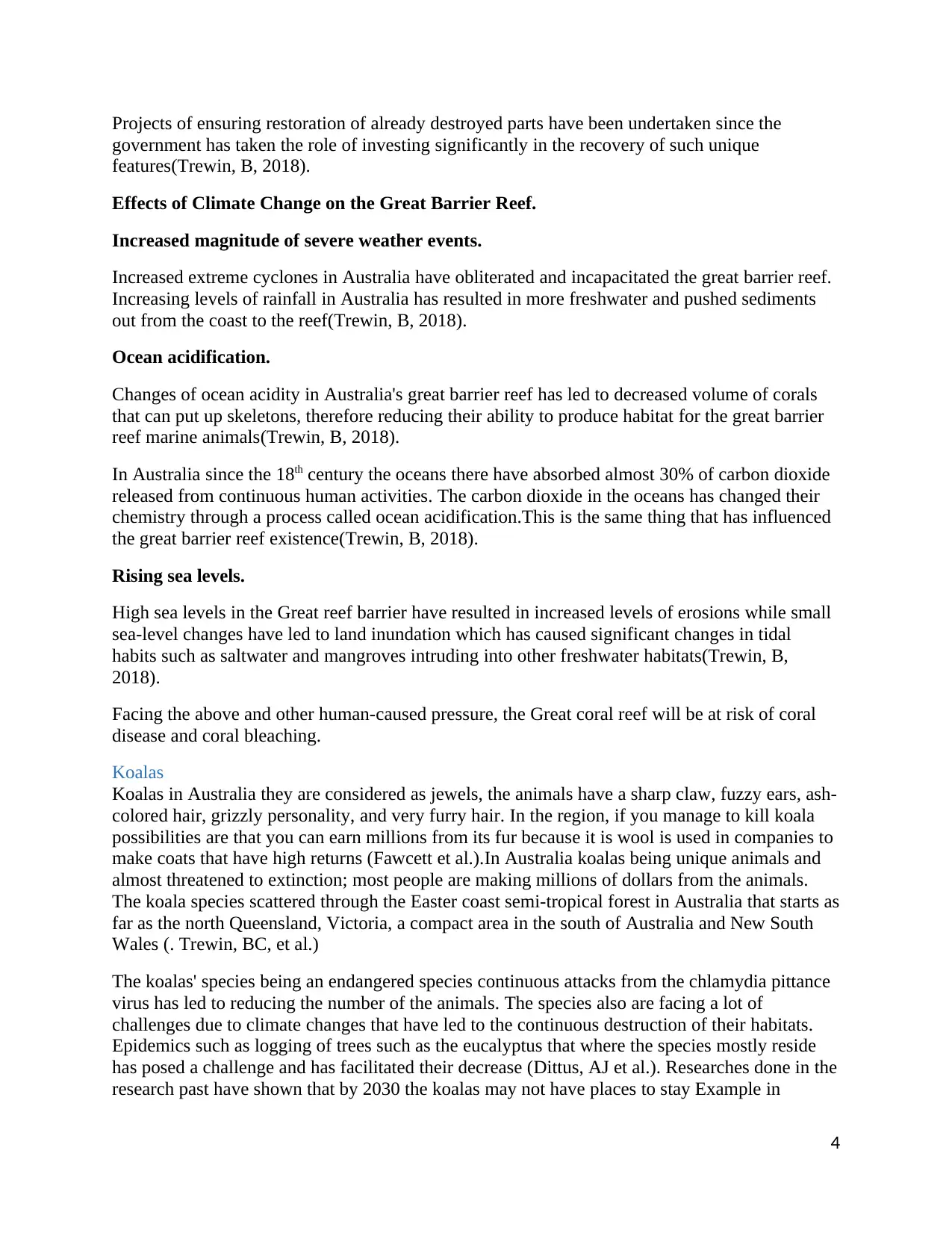
Projects of ensuring restoration of already destroyed parts have been undertaken since the
government has taken the role of investing significantly in the recovery of such unique
features(Trewin, B, 2018).
Effects of Climate Change on the Great Barrier Reef.
Increased magnitude of severe weather events.
Increased extreme cyclones in Australia have obliterated and incapacitated the great barrier reef.
Increasing levels of rainfall in Australia has resulted in more freshwater and pushed sediments
out from the coast to the reef(Trewin, B, 2018).
Ocean acidification.
Changes of ocean acidity in Australia's great barrier reef has led to decreased volume of corals
that can put up skeletons, therefore reducing their ability to produce habitat for the great barrier
reef marine animals(Trewin, B, 2018).
In Australia since the 18th century the oceans there have absorbed almost 30% of carbon dioxide
released from continuous human activities. The carbon dioxide in the oceans has changed their
chemistry through a process called ocean acidification.This is the same thing that has influenced
the great barrier reef existence(Trewin, B, 2018).
Rising sea levels.
High sea levels in the Great reef barrier have resulted in increased levels of erosions while small
sea-level changes have led to land inundation which has caused significant changes in tidal
habits such as saltwater and mangroves intruding into other freshwater habitats(Trewin, B,
2018).
Facing the above and other human-caused pressure, the Great coral reef will be at risk of coral
disease and coral bleaching.
Koalas
Koalas in Australia they are considered as jewels, the animals have a sharp claw, fuzzy ears, ash-
colored hair, grizzly personality, and very furry hair. In the region, if you manage to kill koala
possibilities are that you can earn millions from its fur because it is wool is used in companies to
make coats that have high returns (Fawcett et al.).In Australia koalas being unique animals and
almost threatened to extinction; most people are making millions of dollars from the animals.
The koala species scattered through the Easter coast semi-tropical forest in Australia that starts as
far as the north Queensland, Victoria, a compact area in the south of Australia and New South
Wales (. Trewin, BC, et al.)
The koalas' species being an endangered species continuous attacks from the chlamydia pittance
virus has led to reducing the number of the animals. The species also are facing a lot of
challenges due to climate changes that have led to the continuous destruction of their habitats.
Epidemics such as logging of trees such as the eucalyptus that where the species mostly reside
has posed a challenge and has facilitated their decrease (Dittus, AJ et al.). Researches done in the
research past have shown that by 2030 the koalas may not have places to stay Example in
4
government has taken the role of investing significantly in the recovery of such unique
features(Trewin, B, 2018).
Effects of Climate Change on the Great Barrier Reef.
Increased magnitude of severe weather events.
Increased extreme cyclones in Australia have obliterated and incapacitated the great barrier reef.
Increasing levels of rainfall in Australia has resulted in more freshwater and pushed sediments
out from the coast to the reef(Trewin, B, 2018).
Ocean acidification.
Changes of ocean acidity in Australia's great barrier reef has led to decreased volume of corals
that can put up skeletons, therefore reducing their ability to produce habitat for the great barrier
reef marine animals(Trewin, B, 2018).
In Australia since the 18th century the oceans there have absorbed almost 30% of carbon dioxide
released from continuous human activities. The carbon dioxide in the oceans has changed their
chemistry through a process called ocean acidification.This is the same thing that has influenced
the great barrier reef existence(Trewin, B, 2018).
Rising sea levels.
High sea levels in the Great reef barrier have resulted in increased levels of erosions while small
sea-level changes have led to land inundation which has caused significant changes in tidal
habits such as saltwater and mangroves intruding into other freshwater habitats(Trewin, B,
2018).
Facing the above and other human-caused pressure, the Great coral reef will be at risk of coral
disease and coral bleaching.
Koalas
Koalas in Australia they are considered as jewels, the animals have a sharp claw, fuzzy ears, ash-
colored hair, grizzly personality, and very furry hair. In the region, if you manage to kill koala
possibilities are that you can earn millions from its fur because it is wool is used in companies to
make coats that have high returns (Fawcett et al.).In Australia koalas being unique animals and
almost threatened to extinction; most people are making millions of dollars from the animals.
The koala species scattered through the Easter coast semi-tropical forest in Australia that starts as
far as the north Queensland, Victoria, a compact area in the south of Australia and New South
Wales (. Trewin, BC, et al.)
The koalas' species being an endangered species continuous attacks from the chlamydia pittance
virus has led to reducing the number of the animals. The species also are facing a lot of
challenges due to climate changes that have led to the continuous destruction of their habitats.
Epidemics such as logging of trees such as the eucalyptus that where the species mostly reside
has posed a challenge and has facilitated their decrease (Dittus, AJ et al.). Researches done in the
research past have shown that by 2030 the koalas may not have places to stay Example in
4
Paraphrase This Document
Need a fresh take? Get an instant paraphrase of this document with our AI Paraphraser
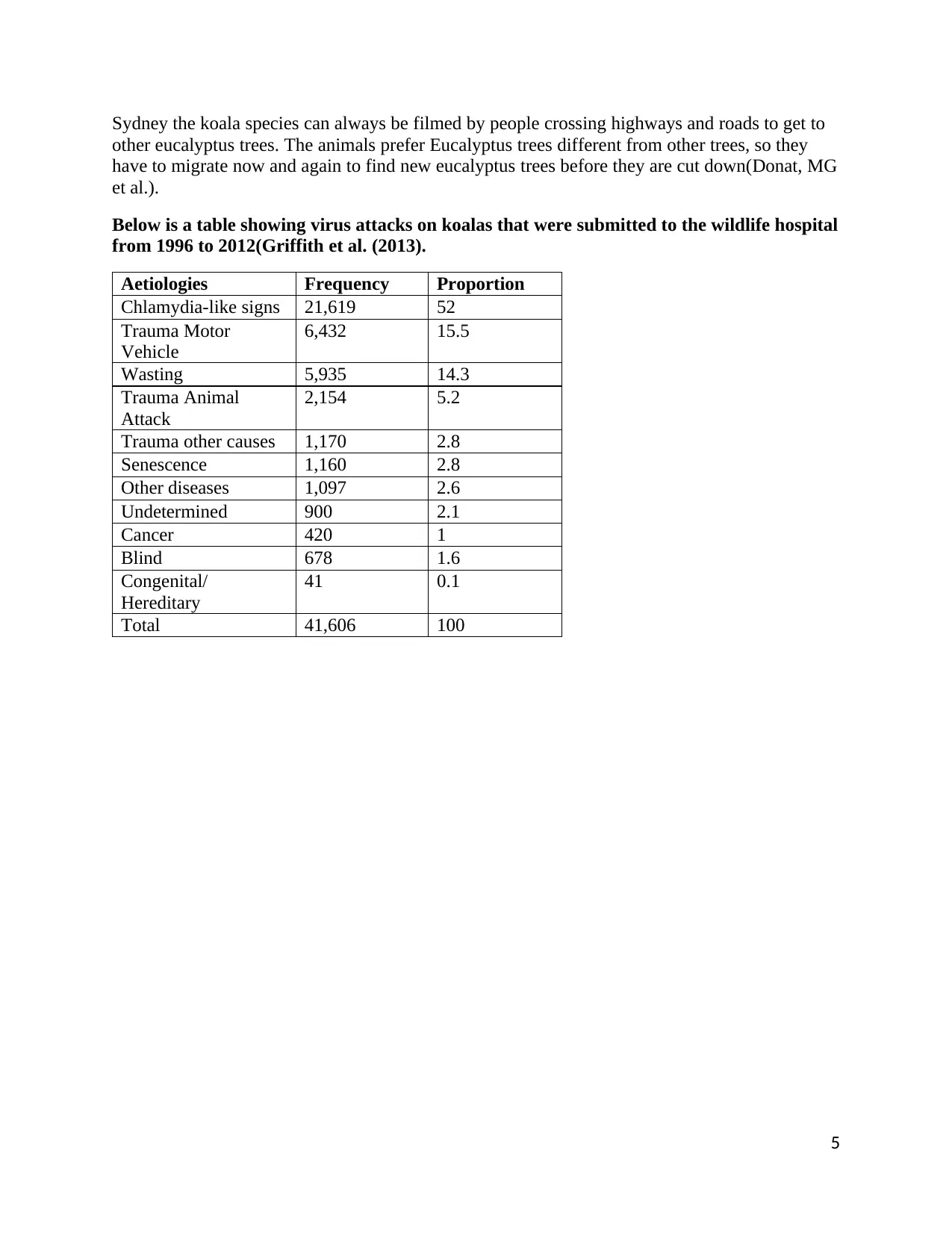
Sydney the koala species can always be filmed by people crossing highways and roads to get to
other eucalyptus trees. The animals prefer Eucalyptus trees different from other trees, so they
have to migrate now and again to find new eucalyptus trees before they are cut down(Donat, MG
et al.).
Below is a table showing virus attacks on koalas that were submitted to the wildlife hospital
from 1996 to 2012(Griffith et al. (2013).
Aetiologies Frequency Proportion
Chlamydia-like signs 21,619 52
Trauma Motor
Vehicle
6,432 15.5
Wasting 5,935 14.3
Trauma Animal
Attack
2,154 5.2
Trauma other causes 1,170 2.8
Senescence 1,160 2.8
Other diseases 1,097 2.6
Undetermined 900 2.1
Cancer 420 1
Blind 678 1.6
Congenital/
Hereditary
41 0.1
Total 41,606 100
5
other eucalyptus trees. The animals prefer Eucalyptus trees different from other trees, so they
have to migrate now and again to find new eucalyptus trees before they are cut down(Donat, MG
et al.).
Below is a table showing virus attacks on koalas that were submitted to the wildlife hospital
from 1996 to 2012(Griffith et al. (2013).
Aetiologies Frequency Proportion
Chlamydia-like signs 21,619 52
Trauma Motor
Vehicle
6,432 15.5
Wasting 5,935 14.3
Trauma Animal
Attack
2,154 5.2
Trauma other causes 1,170 2.8
Senescence 1,160 2.8
Other diseases 1,097 2.6
Undetermined 900 2.1
Cancer 420 1
Blind 678 1.6
Congenital/
Hereditary
41 0.1
Total 41,606 100
5
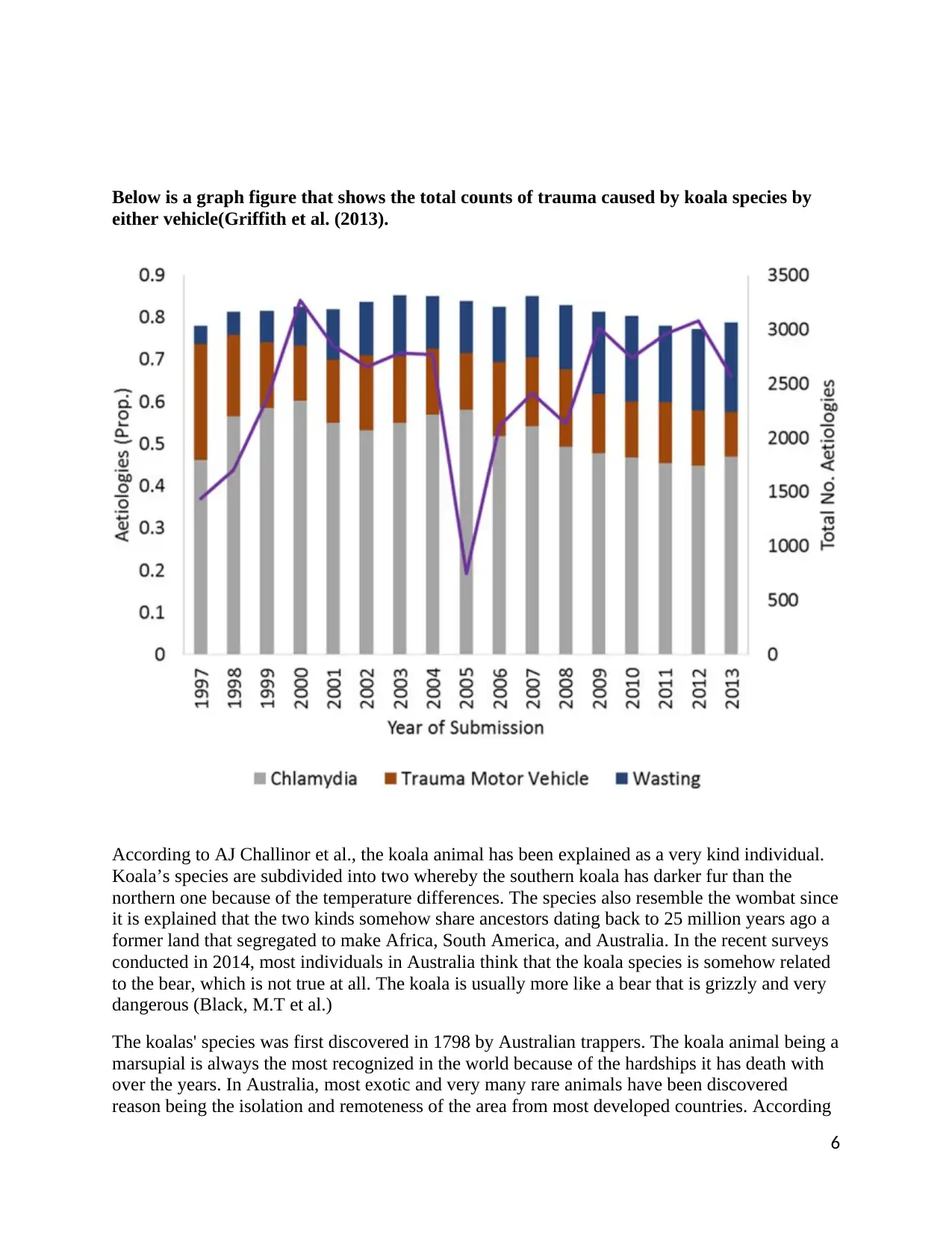
Below is a graph figure that shows the total counts of trauma caused by koala species by
either vehicle(Griffith et al. (2013).
According to AJ Challinor et al., the koala animal has been explained as a very kind individual.
Koala’s species are subdivided into two whereby the southern koala has darker fur than the
northern one because of the temperature differences. The species also resemble the wombat since
it is explained that the two kinds somehow share ancestors dating back to 25 million years ago a
former land that segregated to make Africa, South America, and Australia. In the recent surveys
conducted in 2014, most individuals in Australia think that the koala species is somehow related
to the bear, which is not true at all. The koala is usually more like a bear that is grizzly and very
dangerous (Black, M.T et al.)
The koalas' species was first discovered in 1798 by Australian trappers. The koala animal being a
marsupial is always the most recognized in the world because of the hardships it has death with
over the years. In Australia, most exotic and very many rare animals have been discovered
reason being the isolation and remoteness of the area from most developed countries. According
6
either vehicle(Griffith et al. (2013).
According to AJ Challinor et al., the koala animal has been explained as a very kind individual.
Koala’s species are subdivided into two whereby the southern koala has darker fur than the
northern one because of the temperature differences. The species also resemble the wombat since
it is explained that the two kinds somehow share ancestors dating back to 25 million years ago a
former land that segregated to make Africa, South America, and Australia. In the recent surveys
conducted in 2014, most individuals in Australia think that the koala species is somehow related
to the bear, which is not true at all. The koala is usually more like a bear that is grizzly and very
dangerous (Black, M.T et al.)
The koalas' species was first discovered in 1798 by Australian trappers. The koala animal being a
marsupial is always the most recognized in the world because of the hardships it has death with
over the years. In Australia, most exotic and very many rare animals have been discovered
reason being the isolation and remoteness of the area from most developed countries. According
6
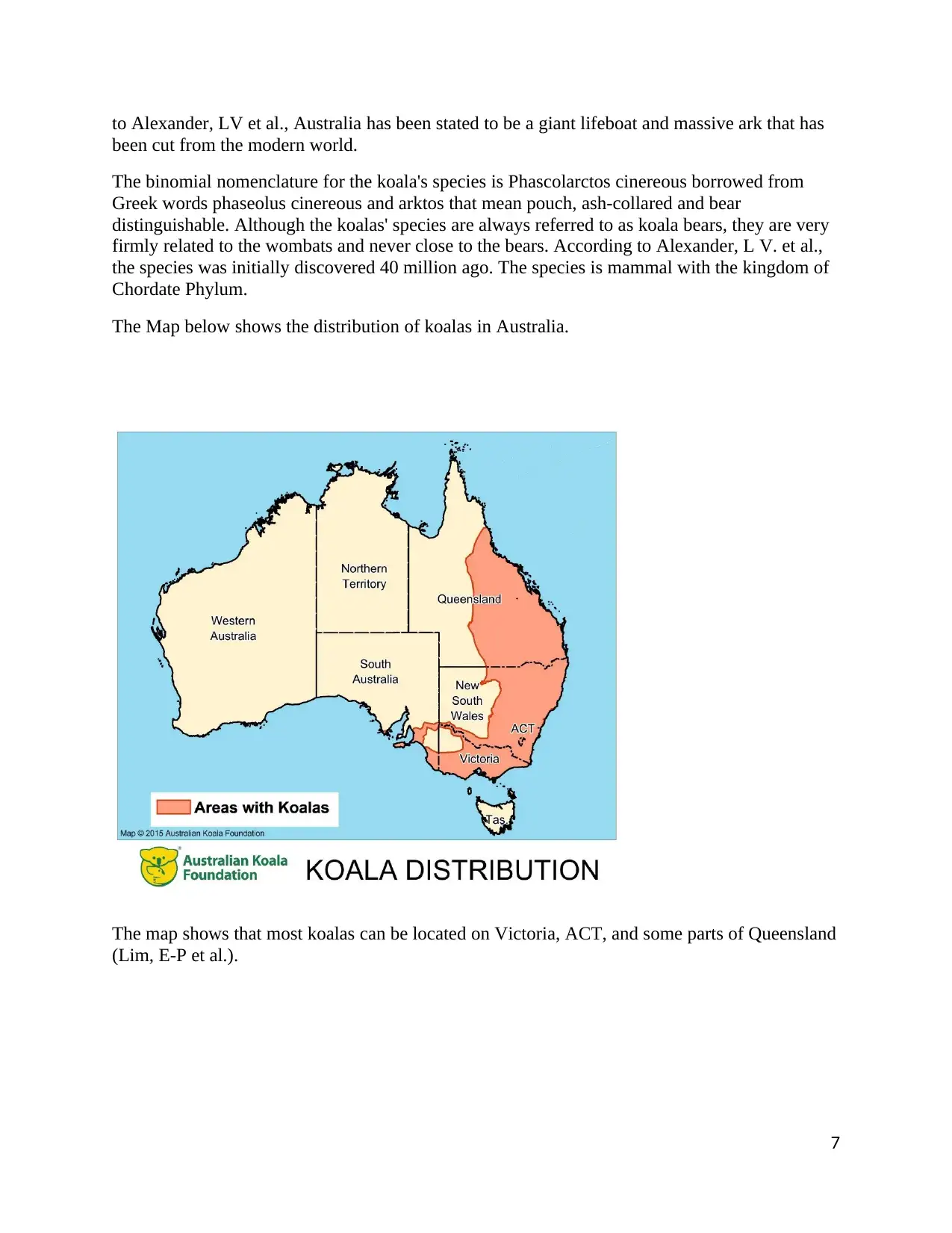
to Alexander, LV et al., Australia has been stated to be a giant lifeboat and massive ark that has
been cut from the modern world.
The binomial nomenclature for the koala's species is Phascolarctos cinereous borrowed from
Greek words phaseolus cinereous and arktos that mean pouch, ash-collared and bear
distinguishable. Although the koalas' species are always referred to as koala bears, they are very
firmly related to the wombats and never close to the bears. According to Alexander, L V. et al.,
the species was initially discovered 40 million ago. The species is mammal with the kingdom of
Chordate Phylum.
The Map below shows the distribution of koalas in Australia.
The map shows that most koalas can be located on Victoria, ACT, and some parts of Queensland
(Lim, E-P et al.).
7
been cut from the modern world.
The binomial nomenclature for the koala's species is Phascolarctos cinereous borrowed from
Greek words phaseolus cinereous and arktos that mean pouch, ash-collared and bear
distinguishable. Although the koalas' species are always referred to as koala bears, they are very
firmly related to the wombats and never close to the bears. According to Alexander, L V. et al.,
the species was initially discovered 40 million ago. The species is mammal with the kingdom of
Chordate Phylum.
The Map below shows the distribution of koalas in Australia.
The map shows that most koalas can be located on Victoria, ACT, and some parts of Queensland
(Lim, E-P et al.).
7
Secure Best Marks with AI Grader
Need help grading? Try our AI Grader for instant feedback on your assignments.
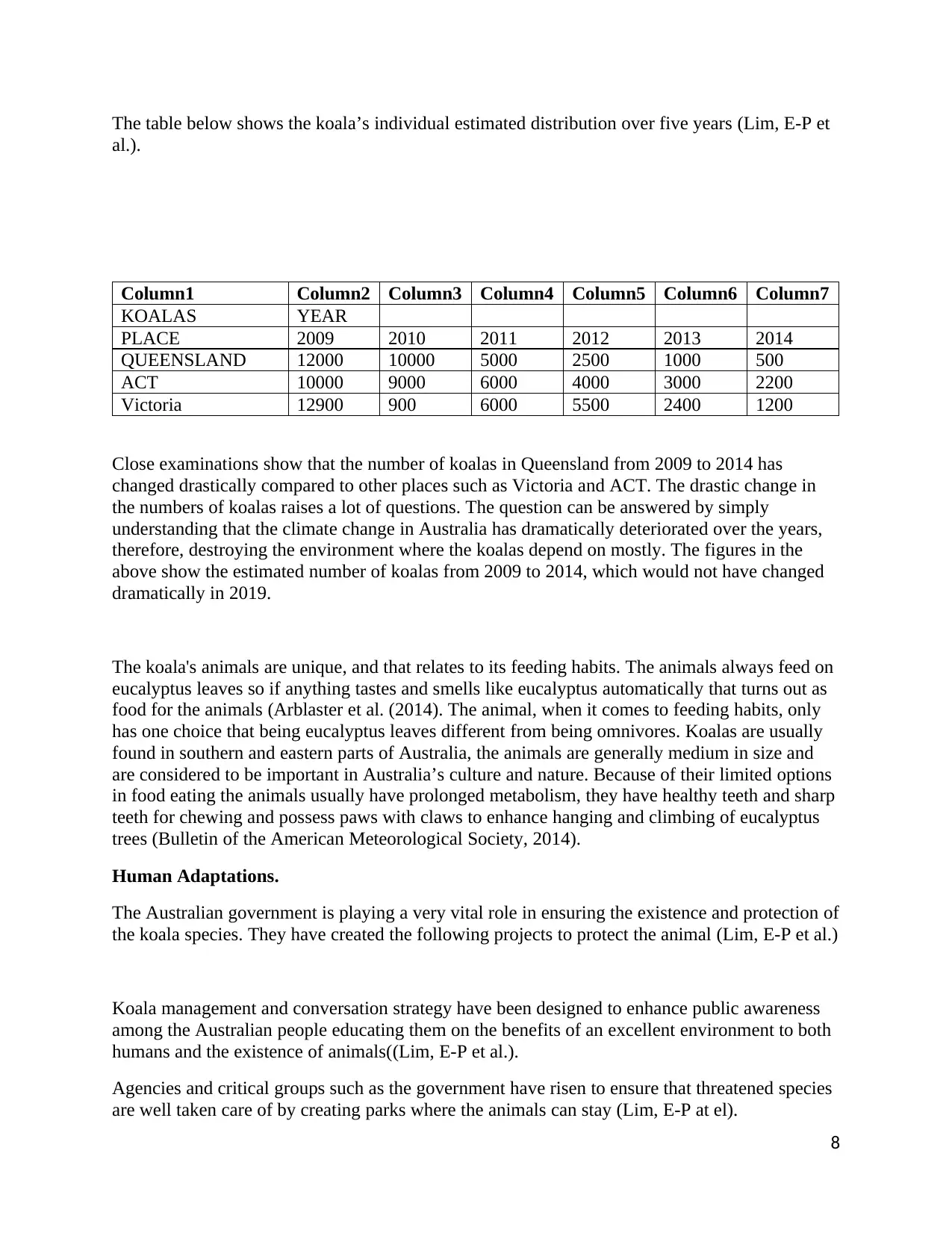
The table below shows the koala’s individual estimated distribution over five years (Lim, E-P et
al.).
Column1 Column2 Column3 Column4 Column5 Column6 Column7
KOALAS YEAR
PLACE 2009 2010 2011 2012 2013 2014
QUEENSLAND 12000 10000 5000 2500 1000 500
ACT 10000 9000 6000 4000 3000 2200
Victoria 12900 900 6000 5500 2400 1200
Close examinations show that the number of koalas in Queensland from 2009 to 2014 has
changed drastically compared to other places such as Victoria and ACT. The drastic change in
the numbers of koalas raises a lot of questions. The question can be answered by simply
understanding that the climate change in Australia has dramatically deteriorated over the years,
therefore, destroying the environment where the koalas depend on mostly. The figures in the
above show the estimated number of koalas from 2009 to 2014, which would not have changed
dramatically in 2019.
The koala's animals are unique, and that relates to its feeding habits. The animals always feed on
eucalyptus leaves so if anything tastes and smells like eucalyptus automatically that turns out as
food for the animals (Arblaster et al. (2014). The animal, when it comes to feeding habits, only
has one choice that being eucalyptus leaves different from being omnivores. Koalas are usually
found in southern and eastern parts of Australia, the animals are generally medium in size and
are considered to be important in Australia’s culture and nature. Because of their limited options
in food eating the animals usually have prolonged metabolism, they have healthy teeth and sharp
teeth for chewing and possess paws with claws to enhance hanging and climbing of eucalyptus
trees (Bulletin of the American Meteorological Society, 2014).
Human Adaptations.
The Australian government is playing a very vital role in ensuring the existence and protection of
the koala species. They have created the following projects to protect the animal (Lim, E-P et al.)
Koala management and conversation strategy have been designed to enhance public awareness
among the Australian people educating them on the benefits of an excellent environment to both
humans and the existence of animals((Lim, E-P et al.).
Agencies and critical groups such as the government have risen to ensure that threatened species
are well taken care of by creating parks where the animals can stay (Lim, E-P at el).
8
al.).
Column1 Column2 Column3 Column4 Column5 Column6 Column7
KOALAS YEAR
PLACE 2009 2010 2011 2012 2013 2014
QUEENSLAND 12000 10000 5000 2500 1000 500
ACT 10000 9000 6000 4000 3000 2200
Victoria 12900 900 6000 5500 2400 1200
Close examinations show that the number of koalas in Queensland from 2009 to 2014 has
changed drastically compared to other places such as Victoria and ACT. The drastic change in
the numbers of koalas raises a lot of questions. The question can be answered by simply
understanding that the climate change in Australia has dramatically deteriorated over the years,
therefore, destroying the environment where the koalas depend on mostly. The figures in the
above show the estimated number of koalas from 2009 to 2014, which would not have changed
dramatically in 2019.
The koala's animals are unique, and that relates to its feeding habits. The animals always feed on
eucalyptus leaves so if anything tastes and smells like eucalyptus automatically that turns out as
food for the animals (Arblaster et al. (2014). The animal, when it comes to feeding habits, only
has one choice that being eucalyptus leaves different from being omnivores. Koalas are usually
found in southern and eastern parts of Australia, the animals are generally medium in size and
are considered to be important in Australia’s culture and nature. Because of their limited options
in food eating the animals usually have prolonged metabolism, they have healthy teeth and sharp
teeth for chewing and possess paws with claws to enhance hanging and climbing of eucalyptus
trees (Bulletin of the American Meteorological Society, 2014).
Human Adaptations.
The Australian government is playing a very vital role in ensuring the existence and protection of
the koala species. They have created the following projects to protect the animal (Lim, E-P et al.)
Koala management and conversation strategy have been designed to enhance public awareness
among the Australian people educating them on the benefits of an excellent environment to both
humans and the existence of animals((Lim, E-P et al.).
Agencies and critical groups such as the government have risen to ensure that threatened species
are well taken care of by creating parks where the animals can stay (Lim, E-P at el).
8
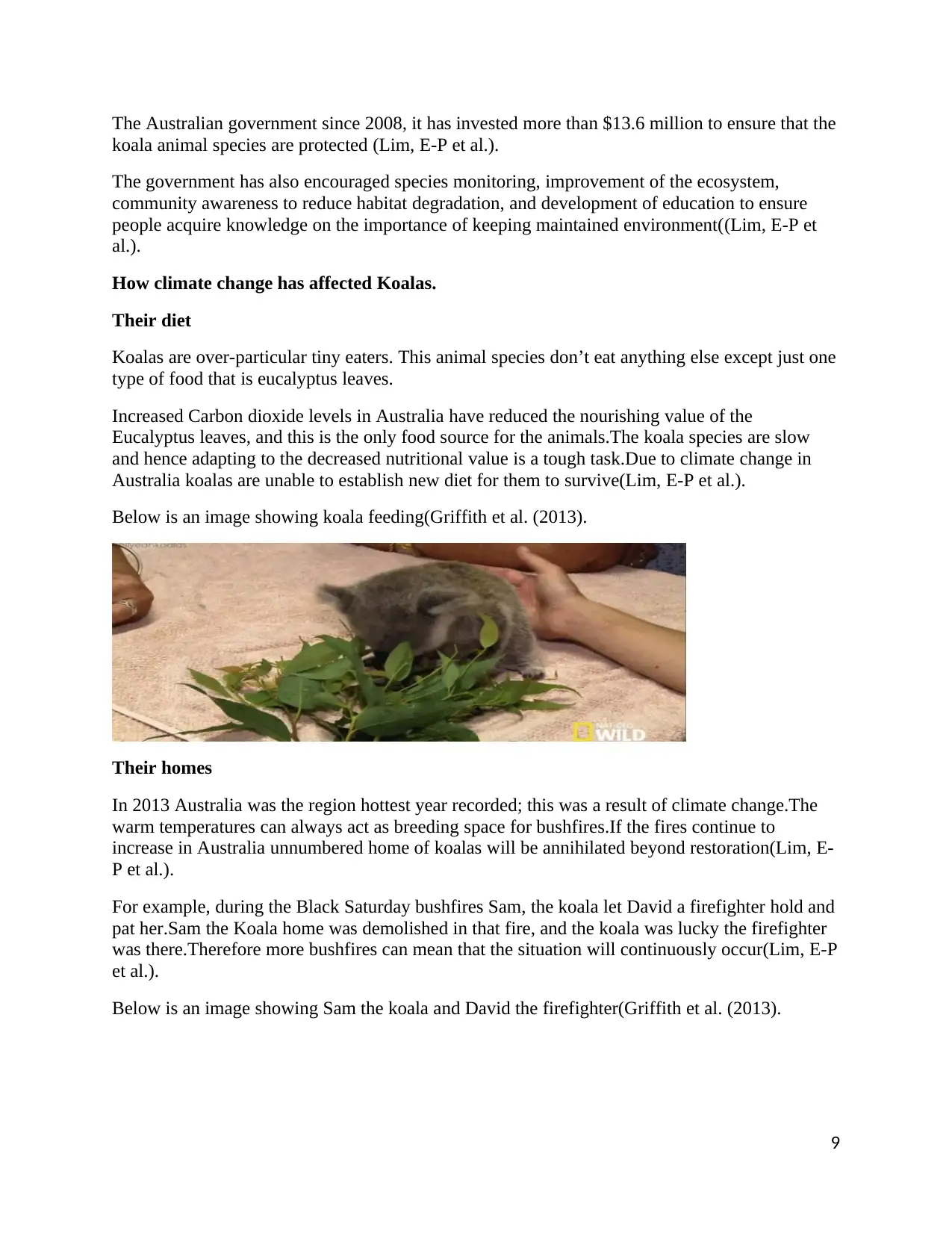
The Australian government since 2008, it has invested more than $13.6 million to ensure that the
koala animal species are protected (Lim, E-P et al.).
The government has also encouraged species monitoring, improvement of the ecosystem,
community awareness to reduce habitat degradation, and development of education to ensure
people acquire knowledge on the importance of keeping maintained environment((Lim, E-P et
al.).
How climate change has affected Koalas.
Their diet
Koalas are over-particular tiny eaters. This animal species don’t eat anything else except just one
type of food that is eucalyptus leaves.
Increased Carbon dioxide levels in Australia have reduced the nourishing value of the
Eucalyptus leaves, and this is the only food source for the animals.The koala species are slow
and hence adapting to the decreased nutritional value is a tough task.Due to climate change in
Australia koalas are unable to establish new diet for them to survive(Lim, E-P et al.).
Below is an image showing koala feeding(Griffith et al. (2013).
Their homes
In 2013 Australia was the region hottest year recorded; this was a result of climate change.The
warm temperatures can always act as breeding space for bushfires.If the fires continue to
increase in Australia unnumbered home of koalas will be annihilated beyond restoration(Lim, E-
P et al.).
For example, during the Black Saturday bushfires Sam, the koala let David a firefighter hold and
pat her.Sam the Koala home was demolished in that fire, and the koala was lucky the firefighter
was there.Therefore more bushfires can mean that the situation will continuously occur(Lim, E-P
et al.).
Below is an image showing Sam the koala and David the firefighter(Griffith et al. (2013).
9
koala animal species are protected (Lim, E-P et al.).
The government has also encouraged species monitoring, improvement of the ecosystem,
community awareness to reduce habitat degradation, and development of education to ensure
people acquire knowledge on the importance of keeping maintained environment((Lim, E-P et
al.).
How climate change has affected Koalas.
Their diet
Koalas are over-particular tiny eaters. This animal species don’t eat anything else except just one
type of food that is eucalyptus leaves.
Increased Carbon dioxide levels in Australia have reduced the nourishing value of the
Eucalyptus leaves, and this is the only food source for the animals.The koala species are slow
and hence adapting to the decreased nutritional value is a tough task.Due to climate change in
Australia koalas are unable to establish new diet for them to survive(Lim, E-P et al.).
Below is an image showing koala feeding(Griffith et al. (2013).
Their homes
In 2013 Australia was the region hottest year recorded; this was a result of climate change.The
warm temperatures can always act as breeding space for bushfires.If the fires continue to
increase in Australia unnumbered home of koalas will be annihilated beyond restoration(Lim, E-
P et al.).
For example, during the Black Saturday bushfires Sam, the koala let David a firefighter hold and
pat her.Sam the Koala home was demolished in that fire, and the koala was lucky the firefighter
was there.Therefore more bushfires can mean that the situation will continuously occur(Lim, E-P
et al.).
Below is an image showing Sam the koala and David the firefighter(Griffith et al. (2013).
9
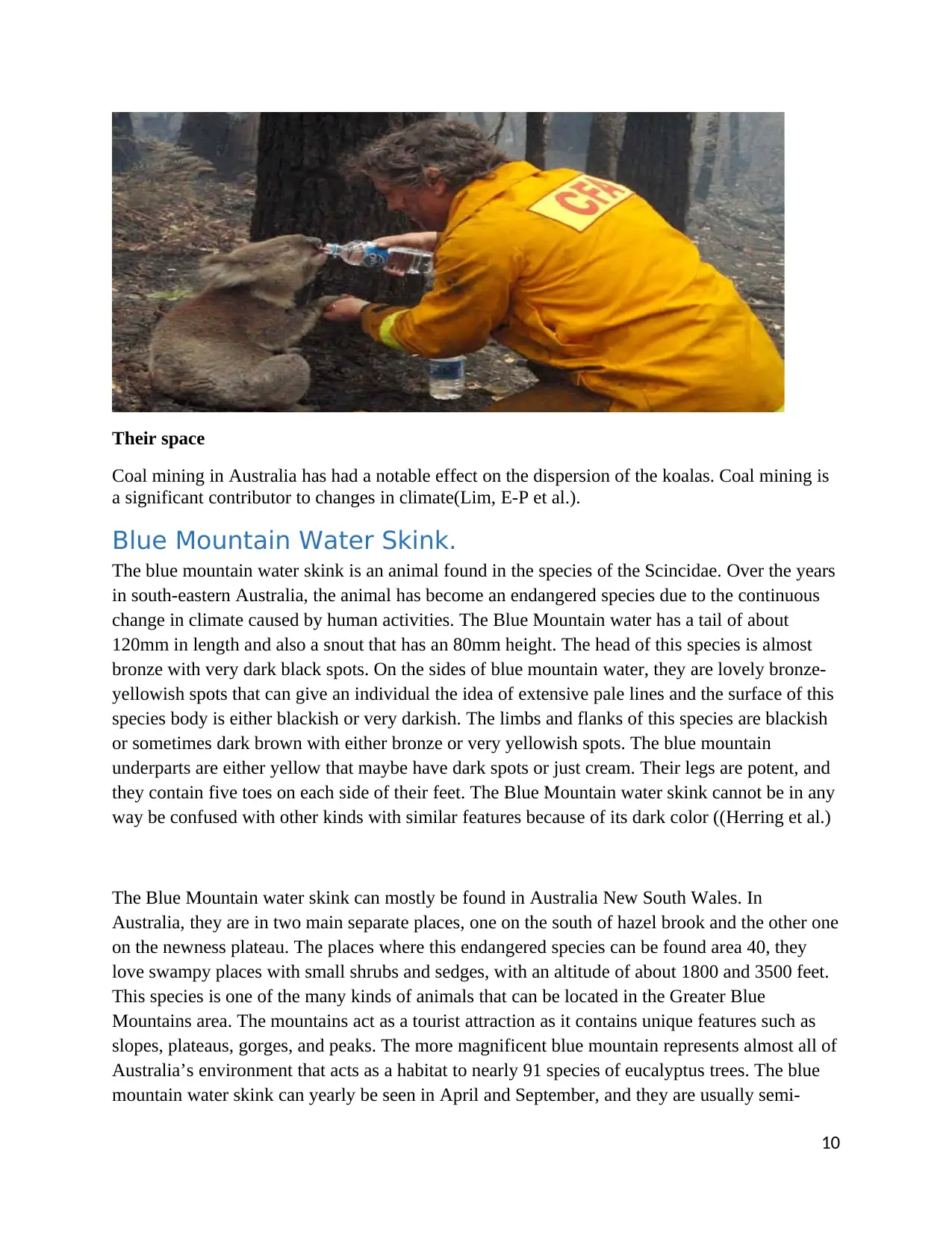
Their space
Coal mining in Australia has had a notable effect on the dispersion of the koalas. Coal mining is
a significant contributor to changes in climate(Lim, E-P et al.).
Blue Mountain Water Skink.
The blue mountain water skink is an animal found in the species of the Scincidae. Over the years
in south-eastern Australia, the animal has become an endangered species due to the continuous
change in climate caused by human activities. The Blue Mountain water has a tail of about
120mm in length and also a snout that has an 80mm height. The head of this species is almost
bronze with very dark black spots. On the sides of blue mountain water, they are lovely bronze-
yellowish spots that can give an individual the idea of extensive pale lines and the surface of this
species body is either blackish or very darkish. The limbs and flanks of this species are blackish
or sometimes dark brown with either bronze or very yellowish spots. The blue mountain
underparts are either yellow that maybe have dark spots or just cream. Their legs are potent, and
they contain five toes on each side of their feet. The Blue Mountain water skink cannot be in any
way be confused with other kinds with similar features because of its dark color ((Herring et al.)
The Blue Mountain water skink can mostly be found in Australia New South Wales. In
Australia, they are in two main separate places, one on the south of hazel brook and the other one
on the newness plateau. The places where this endangered species can be found area 40, they
love swampy places with small shrubs and sedges, with an altitude of about 1800 and 3500 feet.
This species is one of the many kinds of animals that can be located in the Greater Blue
Mountains area. The mountains act as a tourist attraction as it contains unique features such as
slopes, plateaus, gorges, and peaks. The more magnificent blue mountain represents almost all of
Australia’s environment that acts as a habitat to nearly 91 species of eucalyptus trees. The blue
mountain water skink can yearly be seen in April and September, and they are usually semi-
10
Coal mining in Australia has had a notable effect on the dispersion of the koalas. Coal mining is
a significant contributor to changes in climate(Lim, E-P et al.).
Blue Mountain Water Skink.
The blue mountain water skink is an animal found in the species of the Scincidae. Over the years
in south-eastern Australia, the animal has become an endangered species due to the continuous
change in climate caused by human activities. The Blue Mountain water has a tail of about
120mm in length and also a snout that has an 80mm height. The head of this species is almost
bronze with very dark black spots. On the sides of blue mountain water, they are lovely bronze-
yellowish spots that can give an individual the idea of extensive pale lines and the surface of this
species body is either blackish or very darkish. The limbs and flanks of this species are blackish
or sometimes dark brown with either bronze or very yellowish spots. The blue mountain
underparts are either yellow that maybe have dark spots or just cream. Their legs are potent, and
they contain five toes on each side of their feet. The Blue Mountain water skink cannot be in any
way be confused with other kinds with similar features because of its dark color ((Herring et al.)
The Blue Mountain water skink can mostly be found in Australia New South Wales. In
Australia, they are in two main separate places, one on the south of hazel brook and the other one
on the newness plateau. The places where this endangered species can be found area 40, they
love swampy places with small shrubs and sedges, with an altitude of about 1800 and 3500 feet.
This species is one of the many kinds of animals that can be located in the Greater Blue
Mountains area. The mountains act as a tourist attraction as it contains unique features such as
slopes, plateaus, gorges, and peaks. The more magnificent blue mountain represents almost all of
Australia’s environment that acts as a habitat to nearly 91 species of eucalyptus trees. The blue
mountain water skink can yearly be seen in April and September, and they are usually semi-
10
Paraphrase This Document
Need a fresh take? Get an instant paraphrase of this document with our AI Paraphraser
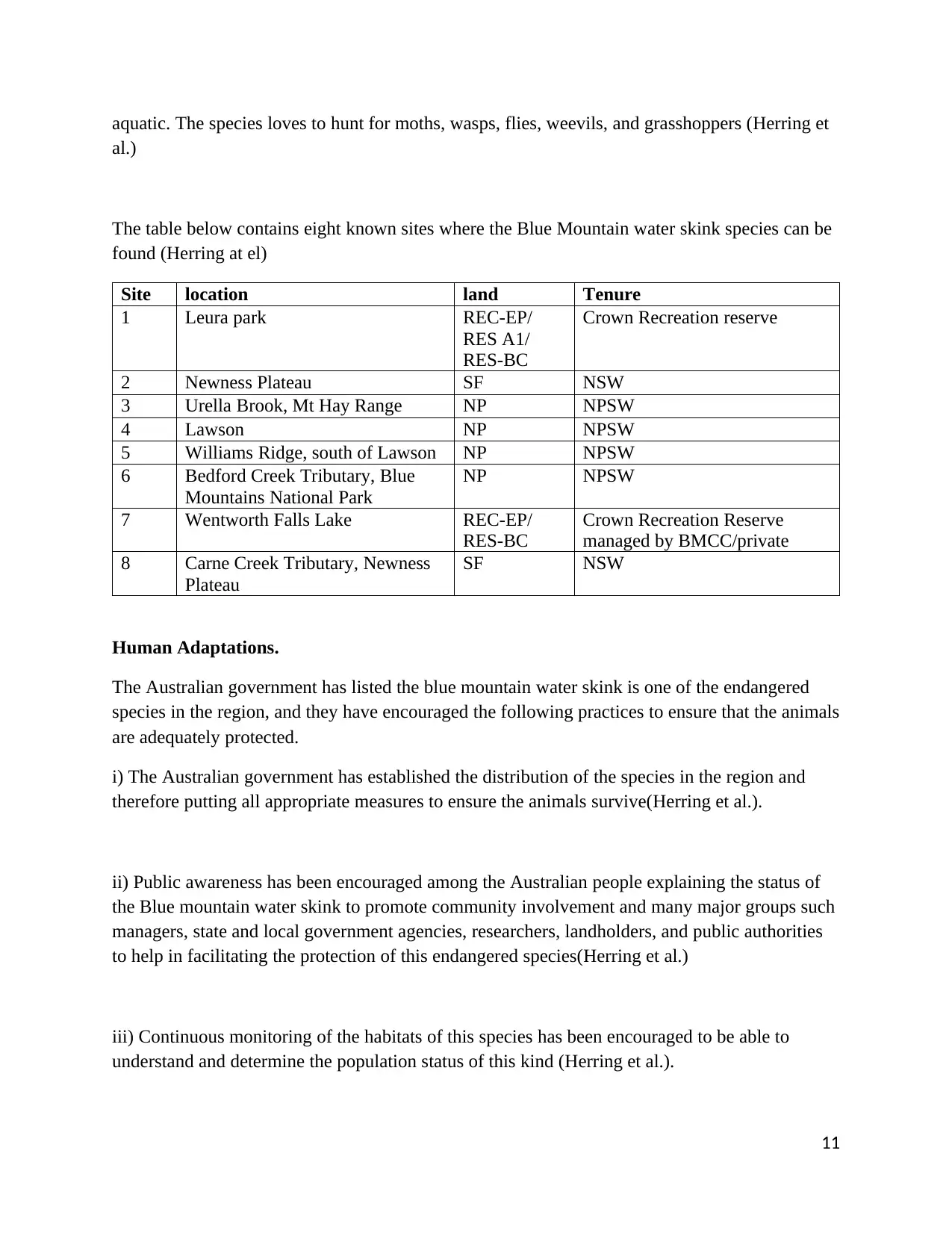
aquatic. The species loves to hunt for moths, wasps, flies, weevils, and grasshoppers (Herring et
al.)
The table below contains eight known sites where the Blue Mountain water skink species can be
found (Herring at el)
Site location land Tenure
1 Leura park REC-EP/
RES A1/
RES-BC
Crown Recreation reserve
2 Newness Plateau SF NSW
3 Urella Brook, Mt Hay Range NP NPSW
4 Lawson NP NPSW
5 Williams Ridge, south of Lawson NP NPSW
6 Bedford Creek Tributary, Blue
Mountains National Park
NP NPSW
7 Wentworth Falls Lake REC-EP/
RES-BC
Crown Recreation Reserve
managed by BMCC/private
8 Carne Creek Tributary, Newness
Plateau
SF NSW
Human Adaptations.
The Australian government has listed the blue mountain water skink is one of the endangered
species in the region, and they have encouraged the following practices to ensure that the animals
are adequately protected.
i) The Australian government has established the distribution of the species in the region and
therefore putting all appropriate measures to ensure the animals survive(Herring et al.).
ii) Public awareness has been encouraged among the Australian people explaining the status of
the Blue mountain water skink to promote community involvement and many major groups such
managers, state and local government agencies, researchers, landholders, and public authorities
to help in facilitating the protection of this endangered species(Herring et al.)
iii) Continuous monitoring of the habitats of this species has been encouraged to be able to
understand and determine the population status of this kind (Herring et al.).
11
al.)
The table below contains eight known sites where the Blue Mountain water skink species can be
found (Herring at el)
Site location land Tenure
1 Leura park REC-EP/
RES A1/
RES-BC
Crown Recreation reserve
2 Newness Plateau SF NSW
3 Urella Brook, Mt Hay Range NP NPSW
4 Lawson NP NPSW
5 Williams Ridge, south of Lawson NP NPSW
6 Bedford Creek Tributary, Blue
Mountains National Park
NP NPSW
7 Wentworth Falls Lake REC-EP/
RES-BC
Crown Recreation Reserve
managed by BMCC/private
8 Carne Creek Tributary, Newness
Plateau
SF NSW
Human Adaptations.
The Australian government has listed the blue mountain water skink is one of the endangered
species in the region, and they have encouraged the following practices to ensure that the animals
are adequately protected.
i) The Australian government has established the distribution of the species in the region and
therefore putting all appropriate measures to ensure the animals survive(Herring et al.).
ii) Public awareness has been encouraged among the Australian people explaining the status of
the Blue mountain water skink to promote community involvement and many major groups such
managers, state and local government agencies, researchers, landholders, and public authorities
to help in facilitating the protection of this endangered species(Herring et al.)
iii) Continuous monitoring of the habitats of this species has been encouraged to be able to
understand and determine the population status of this kind (Herring et al.).
11
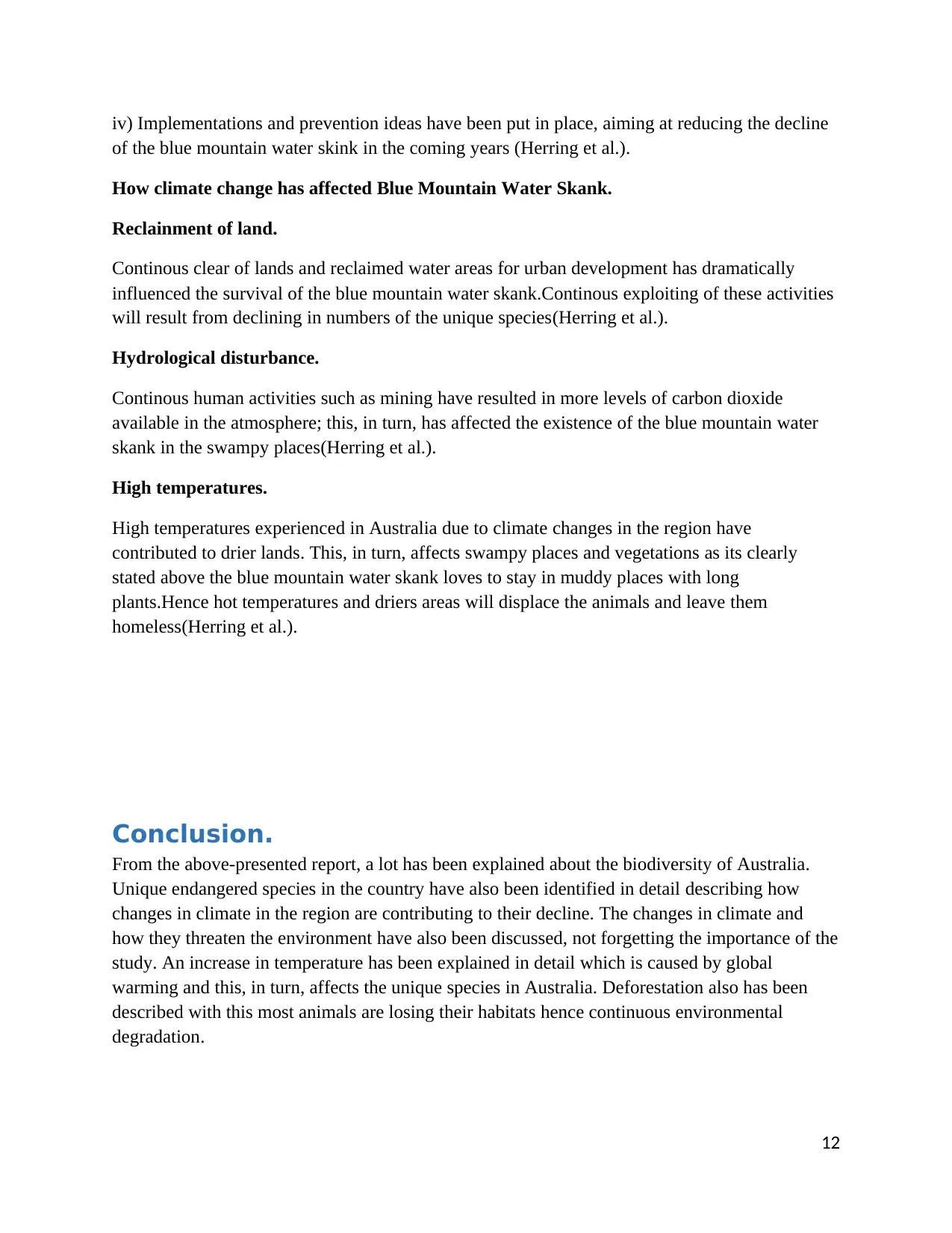
iv) Implementations and prevention ideas have been put in place, aiming at reducing the decline
of the blue mountain water skink in the coming years (Herring et al.).
How climate change has affected Blue Mountain Water Skank.
Reclainment of land.
Continous clear of lands and reclaimed water areas for urban development has dramatically
influenced the survival of the blue mountain water skank.Continous exploiting of these activities
will result from declining in numbers of the unique species(Herring et al.).
Hydrological disturbance.
Continous human activities such as mining have resulted in more levels of carbon dioxide
available in the atmosphere; this, in turn, has affected the existence of the blue mountain water
skank in the swampy places(Herring et al.).
High temperatures.
High temperatures experienced in Australia due to climate changes in the region have
contributed to drier lands. This, in turn, affects swampy places and vegetations as its clearly
stated above the blue mountain water skank loves to stay in muddy places with long
plants.Hence hot temperatures and driers areas will displace the animals and leave them
homeless(Herring et al.).
Conclusion.
From the above-presented report, a lot has been explained about the biodiversity of Australia.
Unique endangered species in the country have also been identified in detail describing how
changes in climate in the region are contributing to their decline. The changes in climate and
how they threaten the environment have also been discussed, not forgetting the importance of the
study. An increase in temperature has been explained in detail which is caused by global
warming and this, in turn, affects the unique species in Australia. Deforestation also has been
described with this most animals are losing their habitats hence continuous environmental
degradation.
12
of the blue mountain water skink in the coming years (Herring et al.).
How climate change has affected Blue Mountain Water Skank.
Reclainment of land.
Continous clear of lands and reclaimed water areas for urban development has dramatically
influenced the survival of the blue mountain water skank.Continous exploiting of these activities
will result from declining in numbers of the unique species(Herring et al.).
Hydrological disturbance.
Continous human activities such as mining have resulted in more levels of carbon dioxide
available in the atmosphere; this, in turn, has affected the existence of the blue mountain water
skank in the swampy places(Herring et al.).
High temperatures.
High temperatures experienced in Australia due to climate changes in the region have
contributed to drier lands. This, in turn, affects swampy places and vegetations as its clearly
stated above the blue mountain water skank loves to stay in muddy places with long
plants.Hence hot temperatures and driers areas will displace the animals and leave them
homeless(Herring et al.).
Conclusion.
From the above-presented report, a lot has been explained about the biodiversity of Australia.
Unique endangered species in the country have also been identified in detail describing how
changes in climate in the region are contributing to their decline. The changes in climate and
how they threaten the environment have also been discussed, not forgetting the importance of the
study. An increase in temperature has been explained in detail which is caused by global
warming and this, in turn, affects the unique species in Australia. Deforestation also has been
described with this most animals are losing their habitats hence continuous environmental
degradation.
12
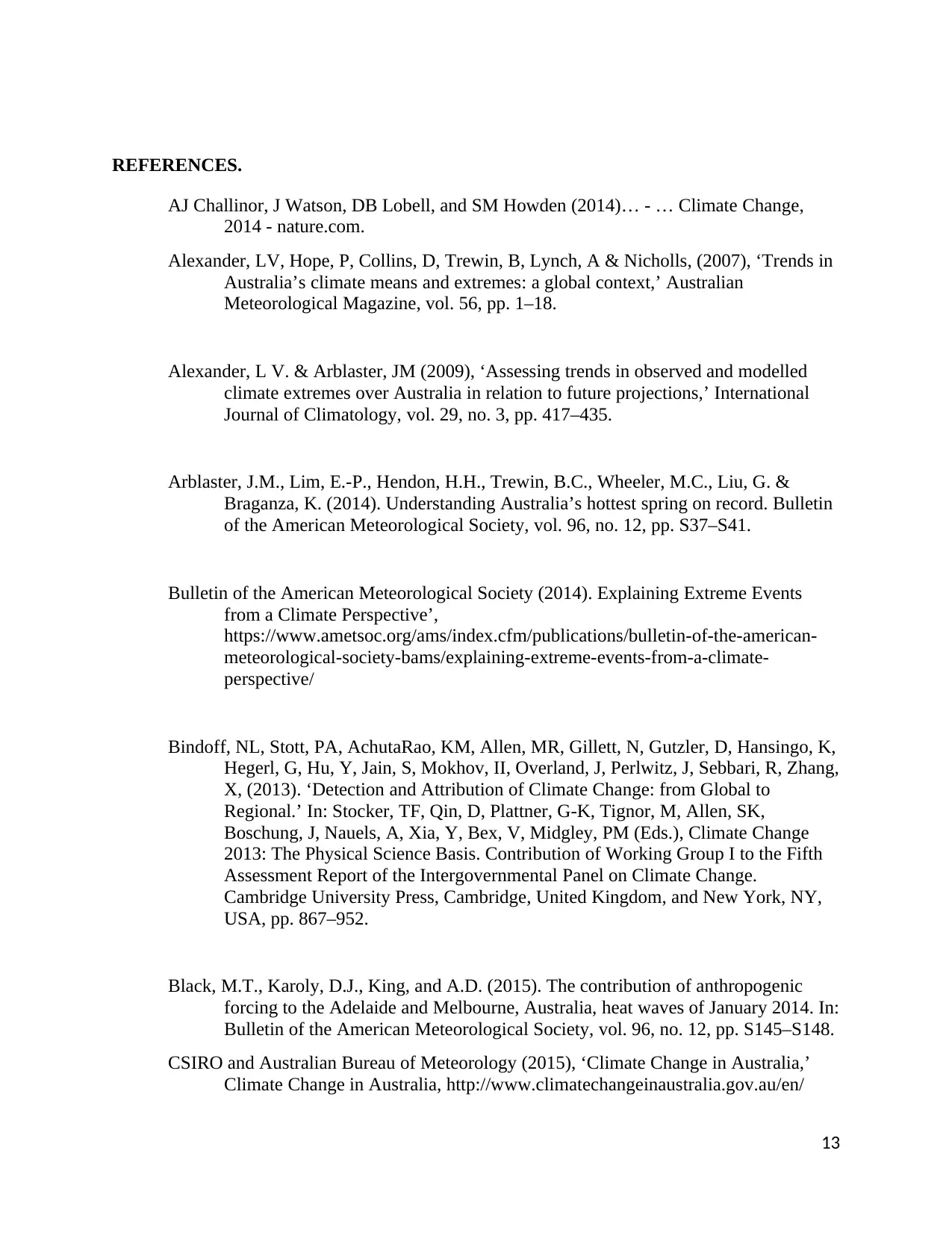
REFERENCES.
AJ Challinor, J Watson, DB Lobell, and SM Howden (2014)… - … Climate Change,
2014 - nature.com.
Alexander, LV, Hope, P, Collins, D, Trewin, B, Lynch, A & Nicholls, (2007), ‘Trends in
Australia’s climate means and extremes: a global context,’ Australian
Meteorological Magazine, vol. 56, pp. 1–18.
Alexander, L V. & Arblaster, JM (2009), ‘Assessing trends in observed and modelled
climate extremes over Australia in relation to future projections,’ International
Journal of Climatology, vol. 29, no. 3, pp. 417–435.
Arblaster, J.M., Lim, E.-P., Hendon, H.H., Trewin, B.C., Wheeler, M.C., Liu, G. &
Braganza, K. (2014). Understanding Australia’s hottest spring on record. Bulletin
of the American Meteorological Society, vol. 96, no. 12, pp. S37–S41.
Bulletin of the American Meteorological Society (2014). Explaining Extreme Events
from a Climate Perspective’,
https://www.ametsoc.org/ams/index.cfm/publications/bulletin-of-the-american-
meteorological-society-bams/explaining-extreme-events-from-a-climate-
perspective/
Bindoff, NL, Stott, PA, AchutaRao, KM, Allen, MR, Gillett, N, Gutzler, D, Hansingo, K,
Hegerl, G, Hu, Y, Jain, S, Mokhov, II, Overland, J, Perlwitz, J, Sebbari, R, Zhang,
X, (2013). ‘Detection and Attribution of Climate Change: from Global to
Regional.’ In: Stocker, TF, Qin, D, Plattner, G-K, Tignor, M, Allen, SK,
Boschung, J, Nauels, A, Xia, Y, Bex, V, Midgley, PM (Eds.), Climate Change
2013: The Physical Science Basis. Contribution of Working Group I to the Fifth
Assessment Report of the Intergovernmental Panel on Climate Change.
Cambridge University Press, Cambridge, United Kingdom, and New York, NY,
USA, pp. 867–952.
Black, M.T., Karoly, D.J., King, and A.D. (2015). The contribution of anthropogenic
forcing to the Adelaide and Melbourne, Australia, heat waves of January 2014. In:
Bulletin of the American Meteorological Society, vol. 96, no. 12, pp. S145–S148.
CSIRO and Australian Bureau of Meteorology (2015), ‘Climate Change in Australia,’
Climate Change in Australia, http://www.climatechangeinaustralia.gov.au/en/
13
AJ Challinor, J Watson, DB Lobell, and SM Howden (2014)… - … Climate Change,
2014 - nature.com.
Alexander, LV, Hope, P, Collins, D, Trewin, B, Lynch, A & Nicholls, (2007), ‘Trends in
Australia’s climate means and extremes: a global context,’ Australian
Meteorological Magazine, vol. 56, pp. 1–18.
Alexander, L V. & Arblaster, JM (2009), ‘Assessing trends in observed and modelled
climate extremes over Australia in relation to future projections,’ International
Journal of Climatology, vol. 29, no. 3, pp. 417–435.
Arblaster, J.M., Lim, E.-P., Hendon, H.H., Trewin, B.C., Wheeler, M.C., Liu, G. &
Braganza, K. (2014). Understanding Australia’s hottest spring on record. Bulletin
of the American Meteorological Society, vol. 96, no. 12, pp. S37–S41.
Bulletin of the American Meteorological Society (2014). Explaining Extreme Events
from a Climate Perspective’,
https://www.ametsoc.org/ams/index.cfm/publications/bulletin-of-the-american-
meteorological-society-bams/explaining-extreme-events-from-a-climate-
perspective/
Bindoff, NL, Stott, PA, AchutaRao, KM, Allen, MR, Gillett, N, Gutzler, D, Hansingo, K,
Hegerl, G, Hu, Y, Jain, S, Mokhov, II, Overland, J, Perlwitz, J, Sebbari, R, Zhang,
X, (2013). ‘Detection and Attribution of Climate Change: from Global to
Regional.’ In: Stocker, TF, Qin, D, Plattner, G-K, Tignor, M, Allen, SK,
Boschung, J, Nauels, A, Xia, Y, Bex, V, Midgley, PM (Eds.), Climate Change
2013: The Physical Science Basis. Contribution of Working Group I to the Fifth
Assessment Report of the Intergovernmental Panel on Climate Change.
Cambridge University Press, Cambridge, United Kingdom, and New York, NY,
USA, pp. 867–952.
Black, M.T., Karoly, D.J., King, and A.D. (2015). The contribution of anthropogenic
forcing to the Adelaide and Melbourne, Australia, heat waves of January 2014. In:
Bulletin of the American Meteorological Society, vol. 96, no. 12, pp. S145–S148.
CSIRO and Australian Bureau of Meteorology (2015), ‘Climate Change in Australia,’
Climate Change in Australia, http://www.climatechangeinaustralia.gov.au/en/
13
Secure Best Marks with AI Grader
Need help grading? Try our AI Grader for instant feedback on your assignments.
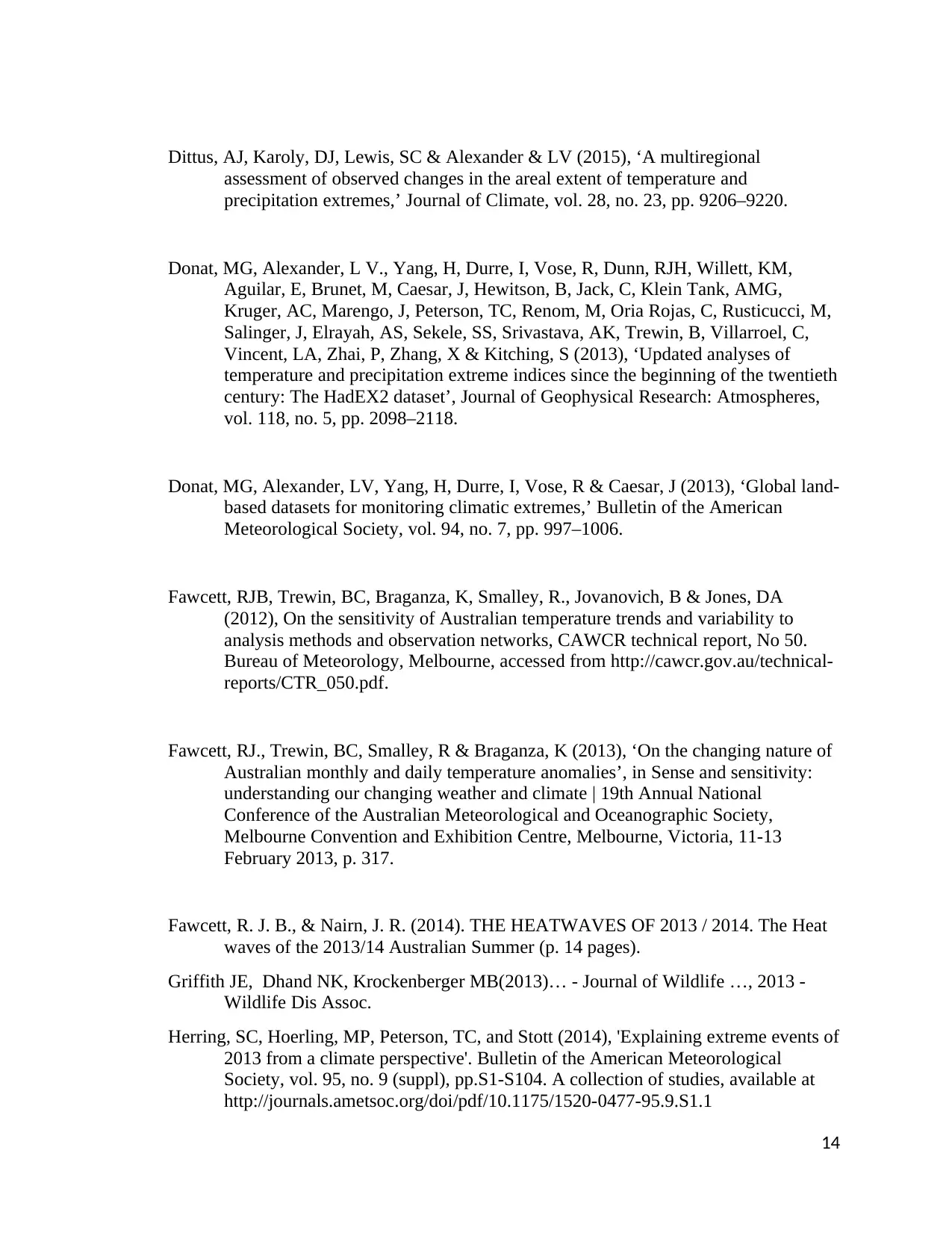
Dittus, AJ, Karoly, DJ, Lewis, SC & Alexander & LV (2015), ‘A multiregional
assessment of observed changes in the areal extent of temperature and
precipitation extremes,’ Journal of Climate, vol. 28, no. 23, pp. 9206–9220.
Donat, MG, Alexander, L V., Yang, H, Durre, I, Vose, R, Dunn, RJH, Willett, KM,
Aguilar, E, Brunet, M, Caesar, J, Hewitson, B, Jack, C, Klein Tank, AMG,
Kruger, AC, Marengo, J, Peterson, TC, Renom, M, Oria Rojas, C, Rusticucci, M,
Salinger, J, Elrayah, AS, Sekele, SS, Srivastava, AK, Trewin, B, Villarroel, C,
Vincent, LA, Zhai, P, Zhang, X & Kitching, S (2013), ‘Updated analyses of
temperature and precipitation extreme indices since the beginning of the twentieth
century: The HadEX2 dataset’, Journal of Geophysical Research: Atmospheres,
vol. 118, no. 5, pp. 2098–2118.
Donat, MG, Alexander, LV, Yang, H, Durre, I, Vose, R & Caesar, J (2013), ‘Global land-
based datasets for monitoring climatic extremes,’ Bulletin of the American
Meteorological Society, vol. 94, no. 7, pp. 997–1006.
Fawcett, RJB, Trewin, BC, Braganza, K, Smalley, R., Jovanovich, B & Jones, DA
(2012), On the sensitivity of Australian temperature trends and variability to
analysis methods and observation networks, CAWCR technical report, No 50.
Bureau of Meteorology, Melbourne, accessed from http://cawcr.gov.au/technical-
reports/CTR_050.pdf.
Fawcett, RJ., Trewin, BC, Smalley, R & Braganza, K (2013), ‘On the changing nature of
Australian monthly and daily temperature anomalies’, in Sense and sensitivity:
understanding our changing weather and climate | 19th Annual National
Conference of the Australian Meteorological and Oceanographic Society,
Melbourne Convention and Exhibition Centre, Melbourne, Victoria, 11-13
February 2013, p. 317.
Fawcett, R. J. B., & Nairn, J. R. (2014). THE HEATWAVES OF 2013 / 2014. The Heat
waves of the 2013/14 Australian Summer (p. 14 pages).
Griffith JE, Dhand NK, Krockenberger MB(2013)… - Journal of Wildlife …, 2013 -
Wildlife Dis Assoc.
Herring, SC, Hoerling, MP, Peterson, TC, and Stott (2014), 'Explaining extreme events of
2013 from a climate perspective'. Bulletin of the American Meteorological
Society, vol. 95, no. 9 (suppl), pp.S1-S104. A collection of studies, available at
http://journals.ametsoc.org/doi/pdf/10.1175/1520-0477-95.9.S1.1
14
assessment of observed changes in the areal extent of temperature and
precipitation extremes,’ Journal of Climate, vol. 28, no. 23, pp. 9206–9220.
Donat, MG, Alexander, L V., Yang, H, Durre, I, Vose, R, Dunn, RJH, Willett, KM,
Aguilar, E, Brunet, M, Caesar, J, Hewitson, B, Jack, C, Klein Tank, AMG,
Kruger, AC, Marengo, J, Peterson, TC, Renom, M, Oria Rojas, C, Rusticucci, M,
Salinger, J, Elrayah, AS, Sekele, SS, Srivastava, AK, Trewin, B, Villarroel, C,
Vincent, LA, Zhai, P, Zhang, X & Kitching, S (2013), ‘Updated analyses of
temperature and precipitation extreme indices since the beginning of the twentieth
century: The HadEX2 dataset’, Journal of Geophysical Research: Atmospheres,
vol. 118, no. 5, pp. 2098–2118.
Donat, MG, Alexander, LV, Yang, H, Durre, I, Vose, R & Caesar, J (2013), ‘Global land-
based datasets for monitoring climatic extremes,’ Bulletin of the American
Meteorological Society, vol. 94, no. 7, pp. 997–1006.
Fawcett, RJB, Trewin, BC, Braganza, K, Smalley, R., Jovanovich, B & Jones, DA
(2012), On the sensitivity of Australian temperature trends and variability to
analysis methods and observation networks, CAWCR technical report, No 50.
Bureau of Meteorology, Melbourne, accessed from http://cawcr.gov.au/technical-
reports/CTR_050.pdf.
Fawcett, RJ., Trewin, BC, Smalley, R & Braganza, K (2013), ‘On the changing nature of
Australian monthly and daily temperature anomalies’, in Sense and sensitivity:
understanding our changing weather and climate | 19th Annual National
Conference of the Australian Meteorological and Oceanographic Society,
Melbourne Convention and Exhibition Centre, Melbourne, Victoria, 11-13
February 2013, p. 317.
Fawcett, R. J. B., & Nairn, J. R. (2014). THE HEATWAVES OF 2013 / 2014. The Heat
waves of the 2013/14 Australian Summer (p. 14 pages).
Griffith JE, Dhand NK, Krockenberger MB(2013)… - Journal of Wildlife …, 2013 -
Wildlife Dis Assoc.
Herring, SC, Hoerling, MP, Peterson, TC, and Stott (2014), 'Explaining extreme events of
2013 from a climate perspective'. Bulletin of the American Meteorological
Society, vol. 95, no. 9 (suppl), pp.S1-S104. A collection of studies, available at
http://journals.ametsoc.org/doi/pdf/10.1175/1520-0477-95.9.S1.1
14
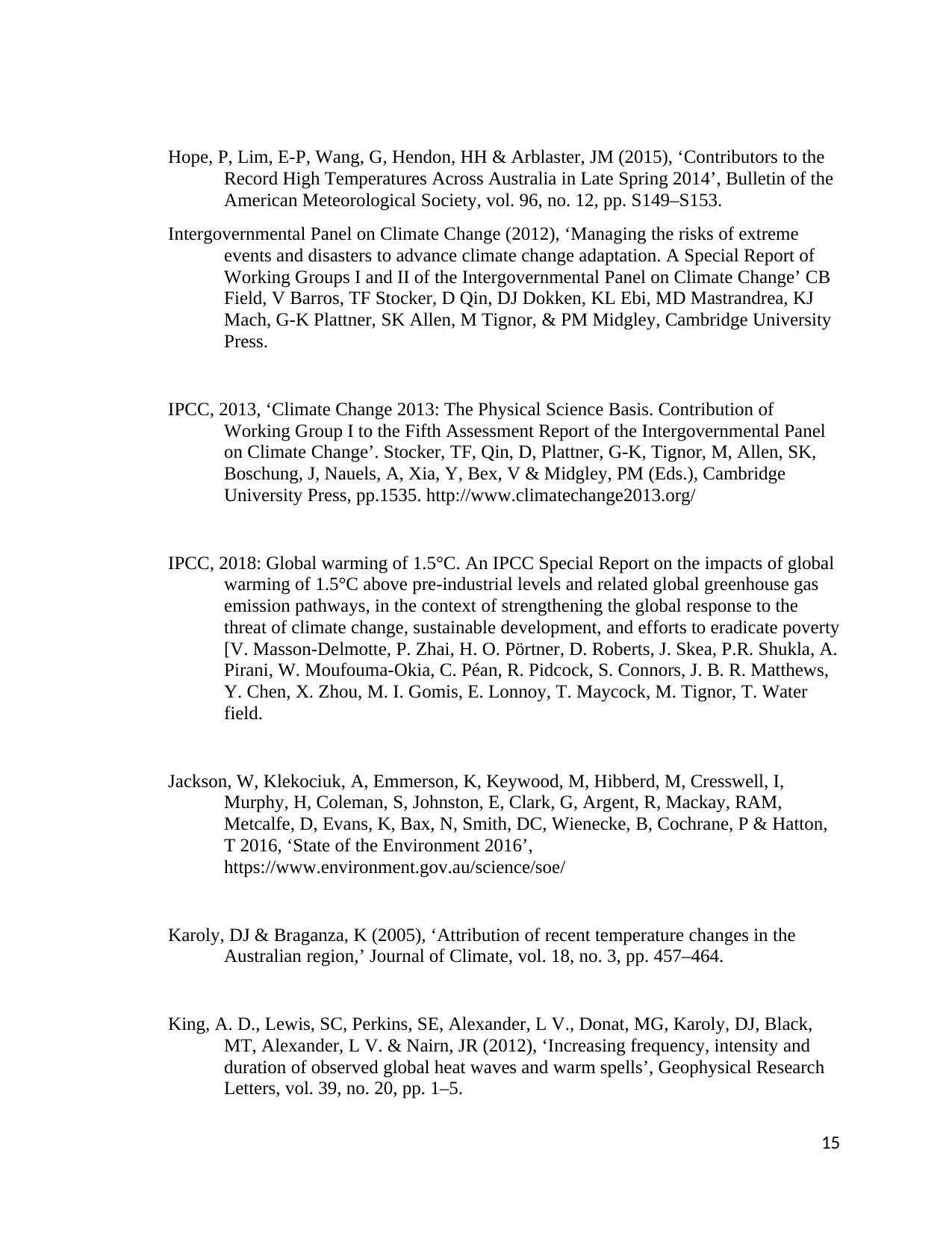
Hope, P, Lim, E-P, Wang, G, Hendon, HH & Arblaster, JM (2015), ‘Contributors to the
Record High Temperatures Across Australia in Late Spring 2014’, Bulletin of the
American Meteorological Society, vol. 96, no. 12, pp. S149–S153.
Intergovernmental Panel on Climate Change (2012), ‘Managing the risks of extreme
events and disasters to advance climate change adaptation. A Special Report of
Working Groups I and II of the Intergovernmental Panel on Climate Change’ CB
Field, V Barros, TF Stocker, D Qin, DJ Dokken, KL Ebi, MD Mastrandrea, KJ
Mach, G-K Plattner, SK Allen, M Tignor, & PM Midgley, Cambridge University
Press.
IPCC, 2013, ‘Climate Change 2013: The Physical Science Basis. Contribution of
Working Group I to the Fifth Assessment Report of the Intergovernmental Panel
on Climate Change’. Stocker, TF, Qin, D, Plattner, G-K, Tignor, M, Allen, SK,
Boschung, J, Nauels, A, Xia, Y, Bex, V & Midgley, PM (Eds.), Cambridge
University Press, pp.1535. http://www.climatechange2013.org/
IPCC, 2018: Global warming of 1.5°C. An IPCC Special Report on the impacts of global
warming of 1.5°C above pre-industrial levels and related global greenhouse gas
emission pathways, in the context of strengthening the global response to the
threat of climate change, sustainable development, and efforts to eradicate poverty
[V. Masson-Delmotte, P. Zhai, H. O. Pörtner, D. Roberts, J. Skea, P.R. Shukla, A.
Pirani, W. Moufouma-Okia, C. Péan, R. Pidcock, S. Connors, J. B. R. Matthews,
Y. Chen, X. Zhou, M. I. Gomis, E. Lonnoy, T. Maycock, M. Tignor, T. Water
field.
Jackson, W, Klekociuk, A, Emmerson, K, Keywood, M, Hibberd, M, Cresswell, I,
Murphy, H, Coleman, S, Johnston, E, Clark, G, Argent, R, Mackay, RAM,
Metcalfe, D, Evans, K, Bax, N, Smith, DC, Wienecke, B, Cochrane, P & Hatton,
T 2016, ‘State of the Environment 2016’,
https://www.environment.gov.au/science/soe/
Karoly, DJ & Braganza, K (2005), ‘Attribution of recent temperature changes in the
Australian region,’ Journal of Climate, vol. 18, no. 3, pp. 457–464.
King, A. D., Lewis, SC, Perkins, SE, Alexander, L V., Donat, MG, Karoly, DJ, Black,
MT, Alexander, L V. & Nairn, JR (2012), ‘Increasing frequency, intensity and
duration of observed global heat waves and warm spells’, Geophysical Research
Letters, vol. 39, no. 20, pp. 1–5.
15
Record High Temperatures Across Australia in Late Spring 2014’, Bulletin of the
American Meteorological Society, vol. 96, no. 12, pp. S149–S153.
Intergovernmental Panel on Climate Change (2012), ‘Managing the risks of extreme
events and disasters to advance climate change adaptation. A Special Report of
Working Groups I and II of the Intergovernmental Panel on Climate Change’ CB
Field, V Barros, TF Stocker, D Qin, DJ Dokken, KL Ebi, MD Mastrandrea, KJ
Mach, G-K Plattner, SK Allen, M Tignor, & PM Midgley, Cambridge University
Press.
IPCC, 2013, ‘Climate Change 2013: The Physical Science Basis. Contribution of
Working Group I to the Fifth Assessment Report of the Intergovernmental Panel
on Climate Change’. Stocker, TF, Qin, D, Plattner, G-K, Tignor, M, Allen, SK,
Boschung, J, Nauels, A, Xia, Y, Bex, V & Midgley, PM (Eds.), Cambridge
University Press, pp.1535. http://www.climatechange2013.org/
IPCC, 2018: Global warming of 1.5°C. An IPCC Special Report on the impacts of global
warming of 1.5°C above pre-industrial levels and related global greenhouse gas
emission pathways, in the context of strengthening the global response to the
threat of climate change, sustainable development, and efforts to eradicate poverty
[V. Masson-Delmotte, P. Zhai, H. O. Pörtner, D. Roberts, J. Skea, P.R. Shukla, A.
Pirani, W. Moufouma-Okia, C. Péan, R. Pidcock, S. Connors, J. B. R. Matthews,
Y. Chen, X. Zhou, M. I. Gomis, E. Lonnoy, T. Maycock, M. Tignor, T. Water
field.
Jackson, W, Klekociuk, A, Emmerson, K, Keywood, M, Hibberd, M, Cresswell, I,
Murphy, H, Coleman, S, Johnston, E, Clark, G, Argent, R, Mackay, RAM,
Metcalfe, D, Evans, K, Bax, N, Smith, DC, Wienecke, B, Cochrane, P & Hatton,
T 2016, ‘State of the Environment 2016’,
https://www.environment.gov.au/science/soe/
Karoly, DJ & Braganza, K (2005), ‘Attribution of recent temperature changes in the
Australian region,’ Journal of Climate, vol. 18, no. 3, pp. 457–464.
King, A. D., Lewis, SC, Perkins, SE, Alexander, L V., Donat, MG, Karoly, DJ, Black,
MT, Alexander, L V. & Nairn, JR (2012), ‘Increasing frequency, intensity and
duration of observed global heat waves and warm spells’, Geophysical Research
Letters, vol. 39, no. 20, pp. 1–5.
15
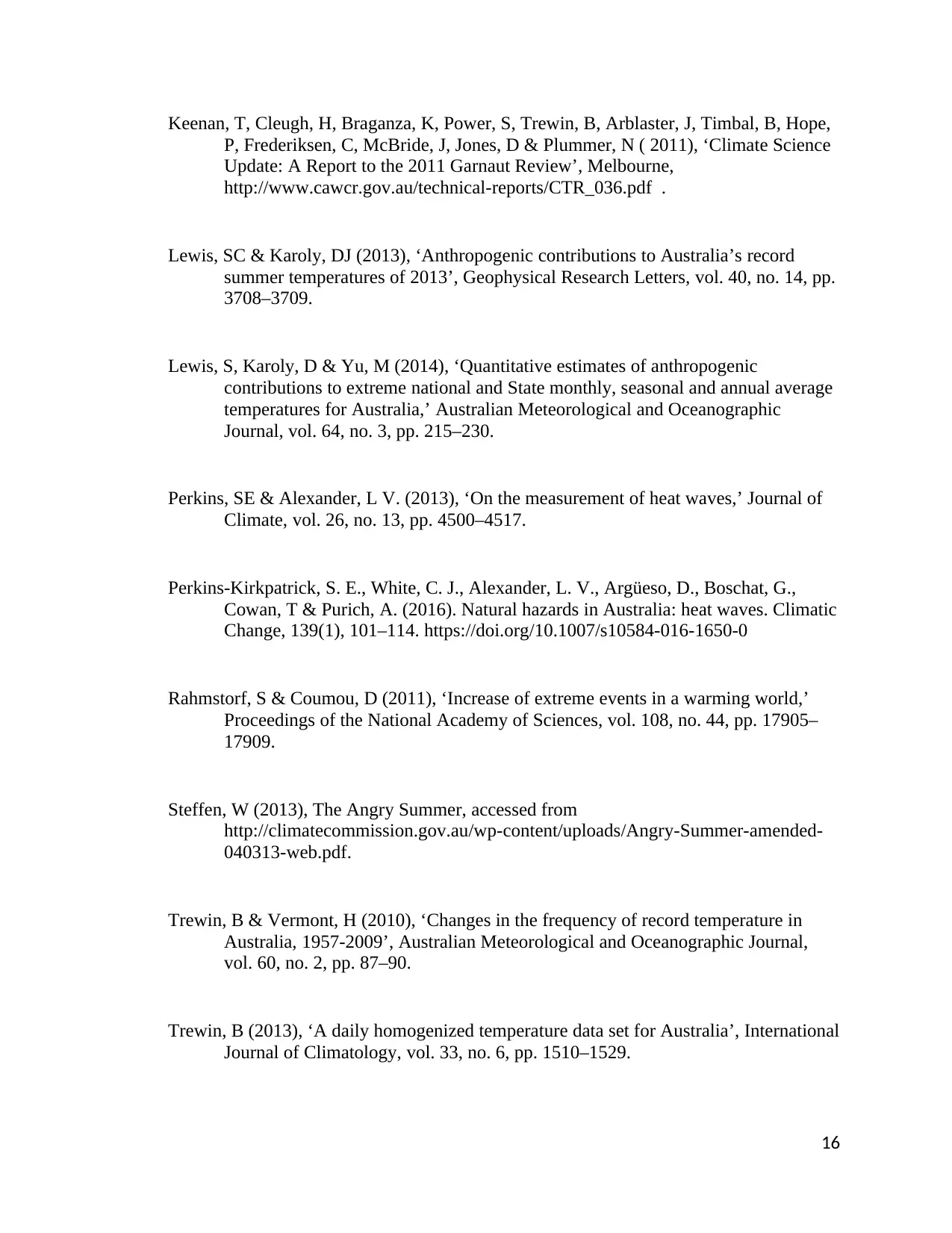
Keenan, T, Cleugh, H, Braganza, K, Power, S, Trewin, B, Arblaster, J, Timbal, B, Hope,
P, Frederiksen, C, McBride, J, Jones, D & Plummer, N ( 2011), ‘Climate Science
Update: A Report to the 2011 Garnaut Review’, Melbourne,
http://www.cawcr.gov.au/technical-reports/CTR_036.pdf .
Lewis, SC & Karoly, DJ (2013), ‘Anthropogenic contributions to Australia’s record
summer temperatures of 2013’, Geophysical Research Letters, vol. 40, no. 14, pp.
3708–3709.
Lewis, S, Karoly, D & Yu, M (2014), ‘Quantitative estimates of anthropogenic
contributions to extreme national and State monthly, seasonal and annual average
temperatures for Australia,’ Australian Meteorological and Oceanographic
Journal, vol. 64, no. 3, pp. 215–230.
Perkins, SE & Alexander, L V. (2013), ‘On the measurement of heat waves,’ Journal of
Climate, vol. 26, no. 13, pp. 4500–4517.
Perkins-Kirkpatrick, S. E., White, C. J., Alexander, L. V., Argüeso, D., Boschat, G.,
Cowan, T & Purich, A. (2016). Natural hazards in Australia: heat waves. Climatic
Change, 139(1), 101–114. https://doi.org/10.1007/s10584-016-1650-0
Rahmstorf, S & Coumou, D (2011), ‘Increase of extreme events in a warming world,’
Proceedings of the National Academy of Sciences, vol. 108, no. 44, pp. 17905–
17909.
Steffen, W (2013), The Angry Summer, accessed from
http://climatecommission.gov.au/wp-content/uploads/Angry-Summer-amended-
040313-web.pdf.
Trewin, B & Vermont, H (2010), ‘Changes in the frequency of record temperature in
Australia, 1957-2009’, Australian Meteorological and Oceanographic Journal,
vol. 60, no. 2, pp. 87–90.
Trewin, B (2013), ‘A daily homogenized temperature data set for Australia’, International
Journal of Climatology, vol. 33, no. 6, pp. 1510–1529.
16
P, Frederiksen, C, McBride, J, Jones, D & Plummer, N ( 2011), ‘Climate Science
Update: A Report to the 2011 Garnaut Review’, Melbourne,
http://www.cawcr.gov.au/technical-reports/CTR_036.pdf .
Lewis, SC & Karoly, DJ (2013), ‘Anthropogenic contributions to Australia’s record
summer temperatures of 2013’, Geophysical Research Letters, vol. 40, no. 14, pp.
3708–3709.
Lewis, S, Karoly, D & Yu, M (2014), ‘Quantitative estimates of anthropogenic
contributions to extreme national and State monthly, seasonal and annual average
temperatures for Australia,’ Australian Meteorological and Oceanographic
Journal, vol. 64, no. 3, pp. 215–230.
Perkins, SE & Alexander, L V. (2013), ‘On the measurement of heat waves,’ Journal of
Climate, vol. 26, no. 13, pp. 4500–4517.
Perkins-Kirkpatrick, S. E., White, C. J., Alexander, L. V., Argüeso, D., Boschat, G.,
Cowan, T & Purich, A. (2016). Natural hazards in Australia: heat waves. Climatic
Change, 139(1), 101–114. https://doi.org/10.1007/s10584-016-1650-0
Rahmstorf, S & Coumou, D (2011), ‘Increase of extreme events in a warming world,’
Proceedings of the National Academy of Sciences, vol. 108, no. 44, pp. 17905–
17909.
Steffen, W (2013), The Angry Summer, accessed from
http://climatecommission.gov.au/wp-content/uploads/Angry-Summer-amended-
040313-web.pdf.
Trewin, B & Vermont, H (2010), ‘Changes in the frequency of record temperature in
Australia, 1957-2009’, Australian Meteorological and Oceanographic Journal,
vol. 60, no. 2, pp. 87–90.
Trewin, B (2013), ‘A daily homogenized temperature data set for Australia’, International
Journal of Climatology, vol. 33, no. 6, pp. 1510–1529.
16
Paraphrase This Document
Need a fresh take? Get an instant paraphrase of this document with our AI Paraphraser
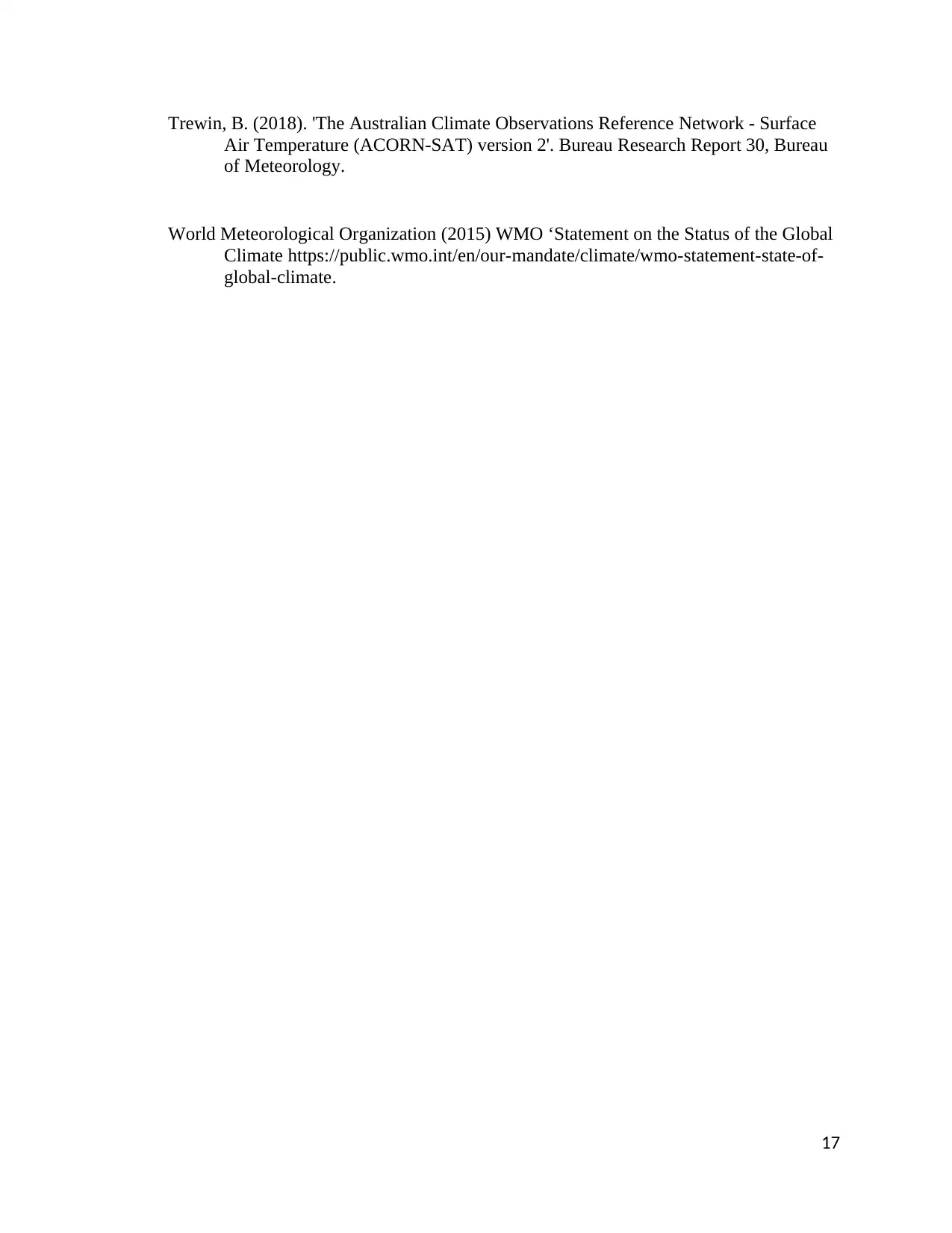
Trewin, B. (2018). 'The Australian Climate Observations Reference Network - Surface
Air Temperature (ACORN-SAT) version 2'. Bureau Research Report 30, Bureau
of Meteorology.
World Meteorological Organization (2015) WMO ‘Statement on the Status of the Global
Climate https://public.wmo.int/en/our-mandate/climate/wmo-statement-state-of-
global-climate.
17
Air Temperature (ACORN-SAT) version 2'. Bureau Research Report 30, Bureau
of Meteorology.
World Meteorological Organization (2015) WMO ‘Statement on the Status of the Global
Climate https://public.wmo.int/en/our-mandate/climate/wmo-statement-state-of-
global-climate.
17
1 out of 20
Your All-in-One AI-Powered Toolkit for Academic Success.
+13062052269
info@desklib.com
Available 24*7 on WhatsApp / Email
![[object Object]](/_next/static/media/star-bottom.7253800d.svg)
Unlock your academic potential
© 2024 | Zucol Services PVT LTD | All rights reserved.





